The city gates of Alsace are integral to the region’s charm, providing access to the historical centres of many villages and cities.
These gates, along with the region’s flowery half-timbered houses, romantic ruined castles, and stunning Romanesque or Gothic churches, contribute significantly to Alsace’s unique character.
As someone captivated by these fortified city gates, I take immense pleasure in photographing them. That’s how I came up with the idea of writing a blog post about them.
Discover the 40 most beautiful fortified city gates of Alsace, listed from north to south, and explore the rich history they guard.
Fortifications in Alsace
In Alsace, some localities saw their medieval castles disappear long ago. This is the case of Riquewihr or Altkirch.
Other towns and villages that were fortified in the Middle Ages are no longer fortified since the 19th century, when their ramparts were razed to make way for “boulevards,” like Colmar.
Finally, many places no longer have their fortified gates: Kaysersberg, Eguisheim, or Obernai.

Fortunately for the tourist who appreciates Alsace, there are still beautiful cities of character that have preserved a part of this medieval heritage:
1. The ramparts of Kientzheim or Bergheim.

2. The fortified castles of Ribeauvillé or Kaysersberg
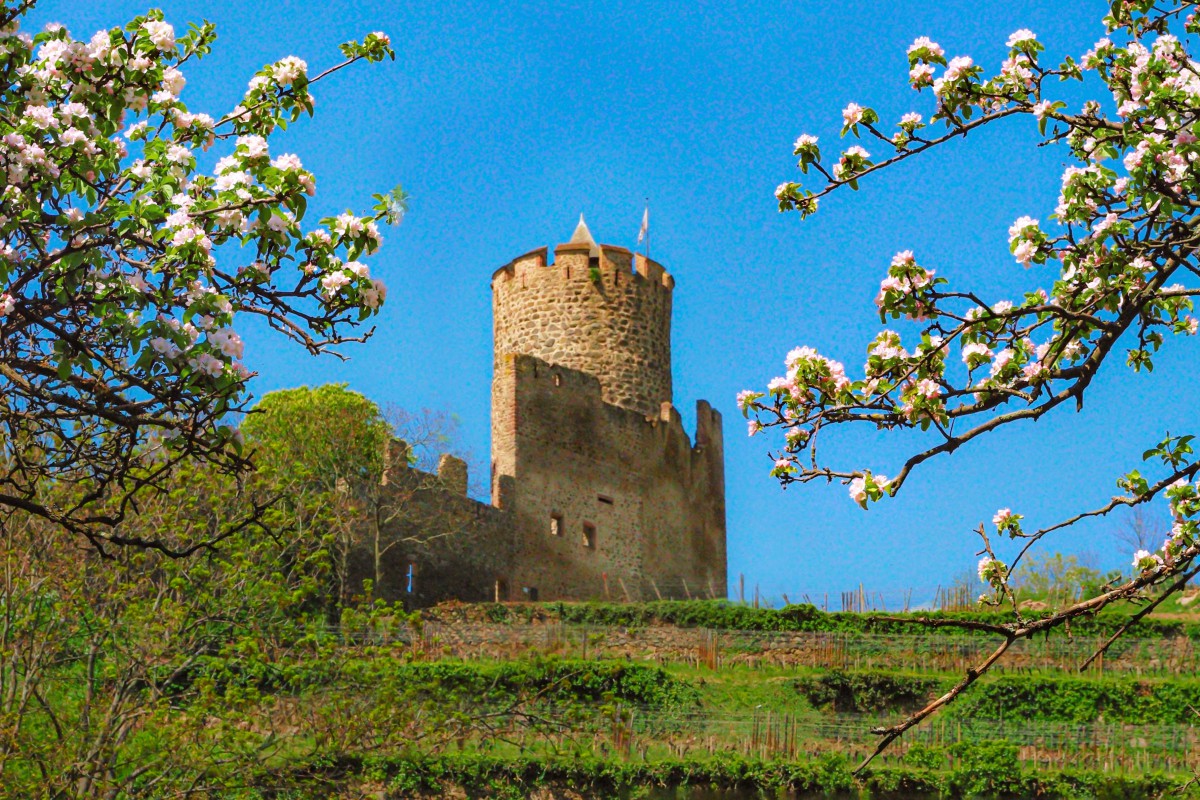
3. And the fortified gates of 25 towns and villages… maybe even more!
The history of city gates in Europe
City gates allowed people, vehicles, goods and animals to enter and leave a fortified city.
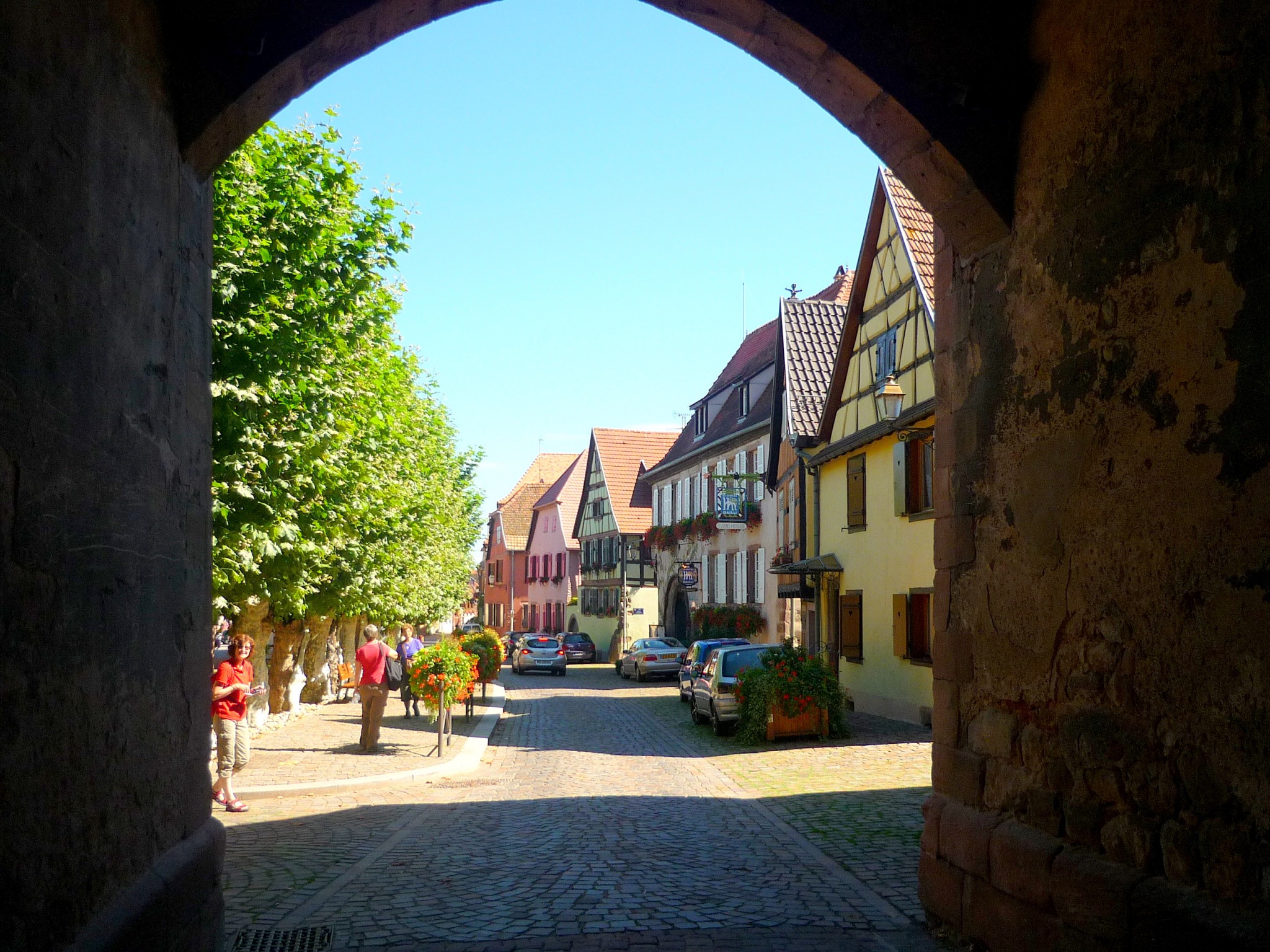
Depending on the historical context, they fulfilled functions related to defence, security, health, commerce, taxation and representation.
In addition, they were staffed by military or municipal authorities.
The city gate: an integral part of the fortifications
The city gate was part of the fortifications of a city. Until the end of the Middle Ages, it was the only place to cross the city walls.
The towers and gates monitored the surroundings and protected the city’s heart from possible enemy attacks.
The city gates could be heavily fortified and decorated with heraldic shields, sculptures, or inscriptions.
They were often equipped with a drawbridge, which made it possible to cross the moat surrounding the city.
The presence of harrows (of wood or iron) and solid oak doors ensured additional protection.
![Fortified City Gates of Alsace - Tour Basse, Bœrsch © David Pursehouse - licence [CC BY 2.0] from Wikimedia Commons](https://frenchmoments.eu/wp-content/uploads/2021/09/Boersch-Tour-Basse-©-David-Pursehouse-licence-CC-BY-2.0-from-Wikimedia-Commons.jpg)
In Alsace, as in Europe, the fortified gates could also serve as a place of warning or intimidation, for example, by displaying the heads of decapitated criminals or public enemies.
In fact, they were commonly used to display various types of public information, such as advertisements, tax and toll schedules, local measurement standards, and legal texts.
The night watchman, guardian of the fortified gates of Alsace
Finally, many towns closed their gates after a curfew each night.
This was the case in Wangen, where a watchman, the “Torwacht“, was responsible for closing the town gates half an hour after the Angelus.
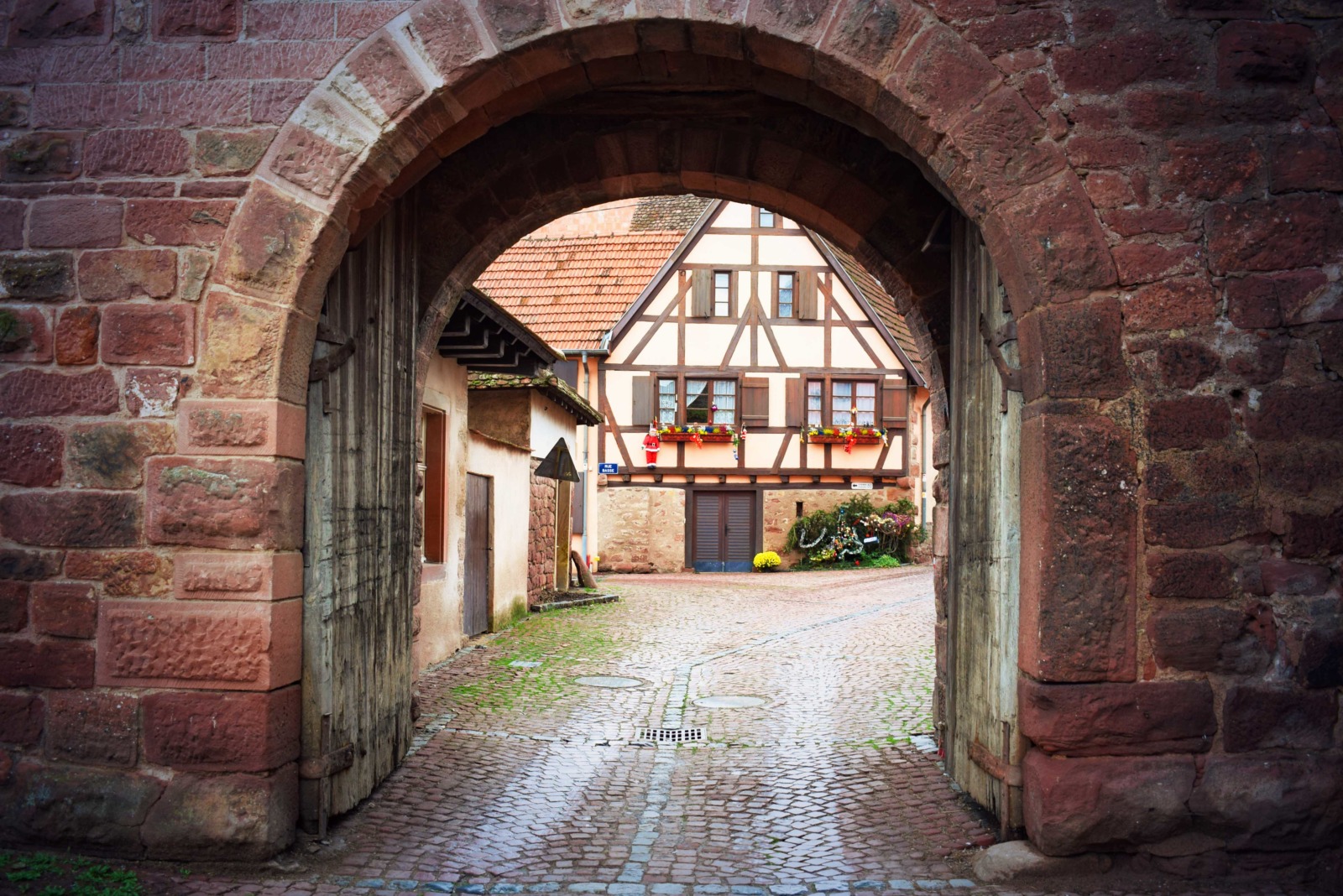
The porter would then go to the “Schultheiss” (mayor) and hand over the keys to the city gates.
From that moment on, no inhabitant could enter or leave the village until the next day.
The guard made his rounds to ensure security and, above all, to ensure that the fires were put out.
City gates from Antiquity to the 18th century
City gates do not only date back to the Middle Ages: the first fortified works can be found in Antiquity.

Then, towards the end of the 18th century, some cities in Europe began to erect city gates without a military function.
They were used as customs gates to collect entry and exit taxes (the wall of the farmers-general in Paris).
Why were city gates removed in the 19th century?
Nevertheless, as political stability and freedom of movement developed, many walled towns removed their city gates.
The increase in road traffic threatened many city gates throughout Europe, so local authorities destroyed them to facilitate traffic.
However, many of them remain in Alsace, France and Germany.
They were built for historical and tourist reasons rather than for safety reasons.
Those gates that have survived have been extensively restored or even rebuilt.
Today, the city gates have become emblems of their cities, playing a tourist role, especially in Alsace and Germany (Riquewihr, Ribeauvillé in Alsace, Speyer, Freiburg-im-Breisgau, Lubeck, Trier in Germany).

The list of the 40 fortified city gates of Alsace
Here is the list of the 40 fortified city gates of Alsace, classified in alphabetical order according to their locality.
If you notice that some of them are missing, please leave me the name of their locality as a comment at the bottom of this article! Thanks in advance for your help, it will enrich this article 🙂
Altkirch
Originally, Altkirch had three city gates and a castle. The latter was razed in the 19th century to make way for the current church.
As for the gates, only one remains: the Vieille-Porte or Belfort Gate (because it gave access to the road to Belfort).

This gate dates from 1245 when the ramparts of Altkirch were constructed. A building was erected above the gate around 1560 and restored in the 18th and 19th centuries, notably to widen it for traffic.
You can see the interior vaults and a dovecote as you pass through the gate. On the exterior side, along the Boulevard Clemenceau, you can still see the remains of the ramparts.
Ammerschwihr
The Porte Haute (or Obertor) of Ammerschwihr dates from the first half of the 14th century.
At about 20 meters high, it is characterized by its high roof, which contains a stork’s nest.
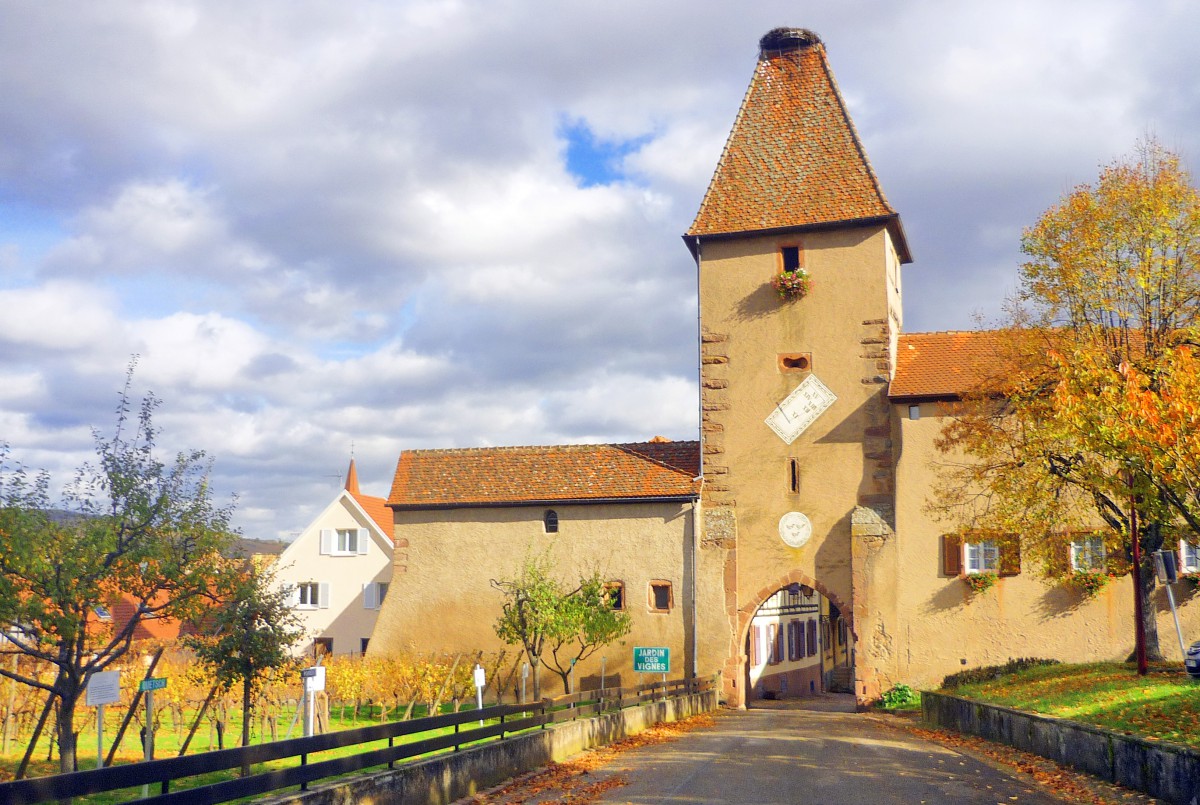
Buttresses and corner chains reinforce the construction.
The upper part of the city gate is timber-framed.
The gate has a pointed arch in the country side and a curved arch in the city side.
Observe the sundials on their two faces.
Belfort
A long time ago, Belfort was part of the Austrian Sundgau.
Today, included in the Burgundy-Franche-Comté region, the Lion City has kept the memory of belonging to Alsace, notably in the aspect of its old town.
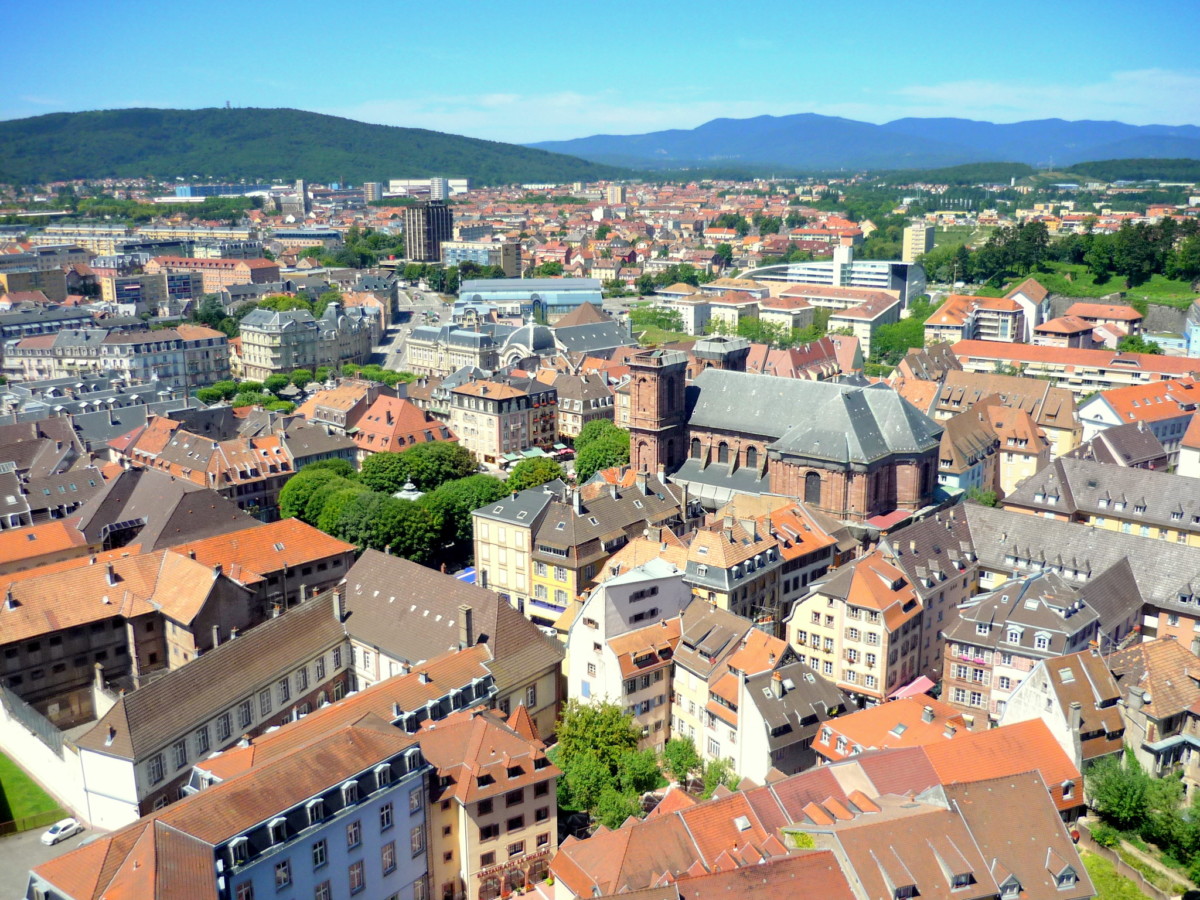
In the second half of the 17th century, Belfort became a royal fortress and a place of war, thanks to the fortifications of Vauban.
Indeed, King Louis XIV commissioned Vauban to build an “iron belt” on the borders of the Kingdom of France.
The military architect built the famous Citadel and developed its ramparts.
In 1687, he completed the construction of the Porte de France (destroyed in 1892) and of the magnificent Porte de Brisach, overlooking the road to the east (and thus to Germany).
The latter has remained in its original state.
![Fortified City Gates of Alsace - Porte de Brisach, Belfort © Andrzej Harassek - licence [CC BY-SA 3.0] from Wikimedia Commons](https://frenchmoments.eu/wp-content/uploads/2021/09/Belfort-Porte-de-Brisach-©-Andrzej-Harassek-licence-CC-BY-SA-3.0-from-Wikimedia-Commons.jpg)
Observe the upper part of the gate: the central medallion adorning it bears three fleurs-de-lis framed by a cluster of flags and trophies.
On the triangular pediment, you can see the sun, Louis XIV’s emblem, accompanied by his motto “Nec pluribus impar” (no one can be compared to him).
![Fortified City Gates of Alsace - Porte de Brisach, Belfort © Krzysztof Golik - licence [CC BY-SA 4.0] from Wikimedia Commons](https://frenchmoments.eu/wp-content/uploads/2021/09/Belfort-Porte-de-Brisach-©-Krzysztof-Golik-licence-CC-BY-SA-4.0-from-Wikimedia-Commons.jpg)
Bergheim
Bergheim is one of the rare Alsatian towns that has kept its double medieval wall.
The historical city is located inside a rectangle of 300 m by 500 m, with rounded corners.
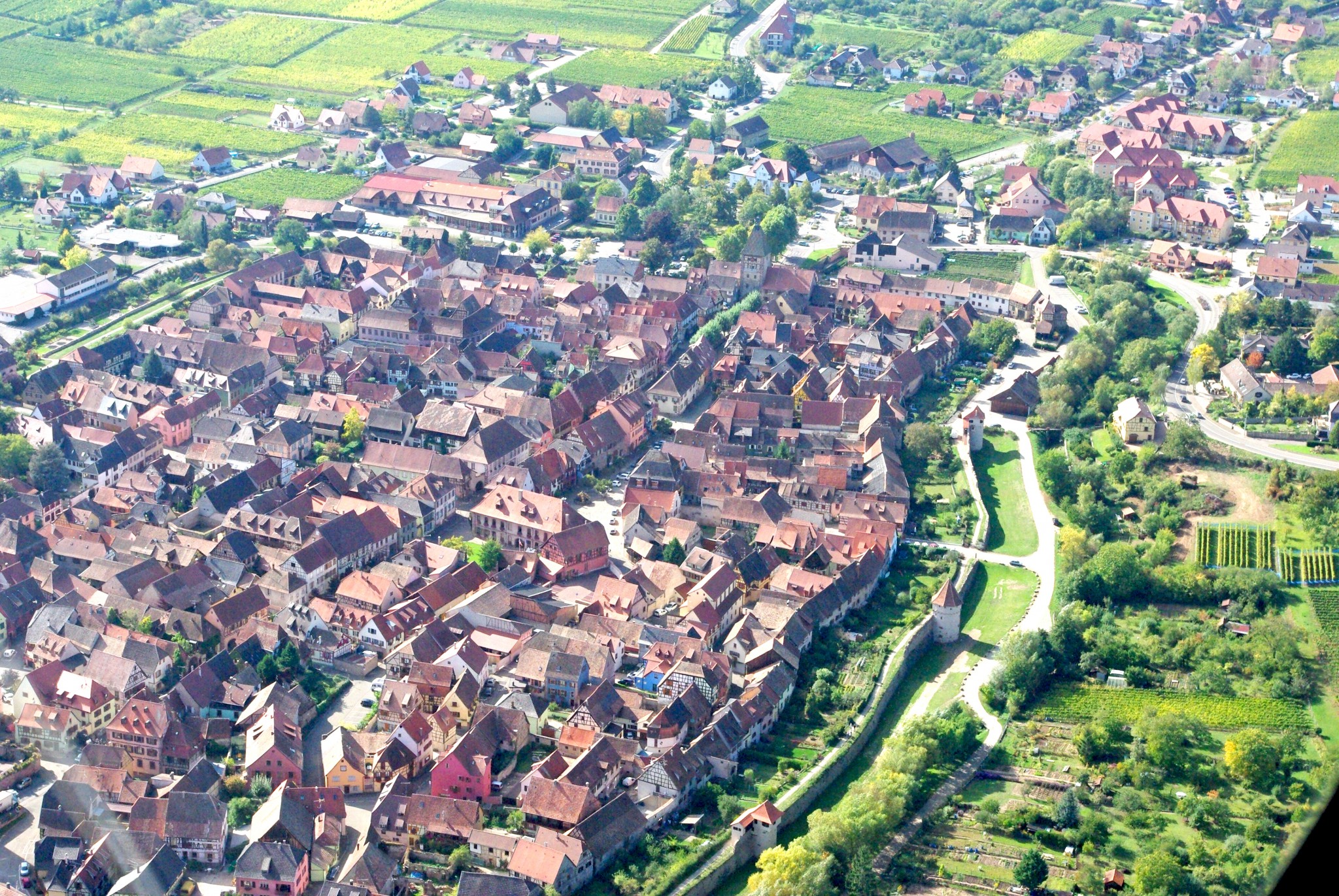
In the Middle Ages, four city gates stood at each of the cardinal points of Bergheim:
- the Neutor in the south towards Guémar,
- the Leimentor to the north,
- the Untertor to the east towards Sélestat
- the Obertor, to the west, opened the road to Ribeauvillé.
It is the latter, dating from 1310, that has come down to us intact.
The Porte Haute (Obertor) stands on the western side of the Bergheim enclosure, rising 22 meters in height.
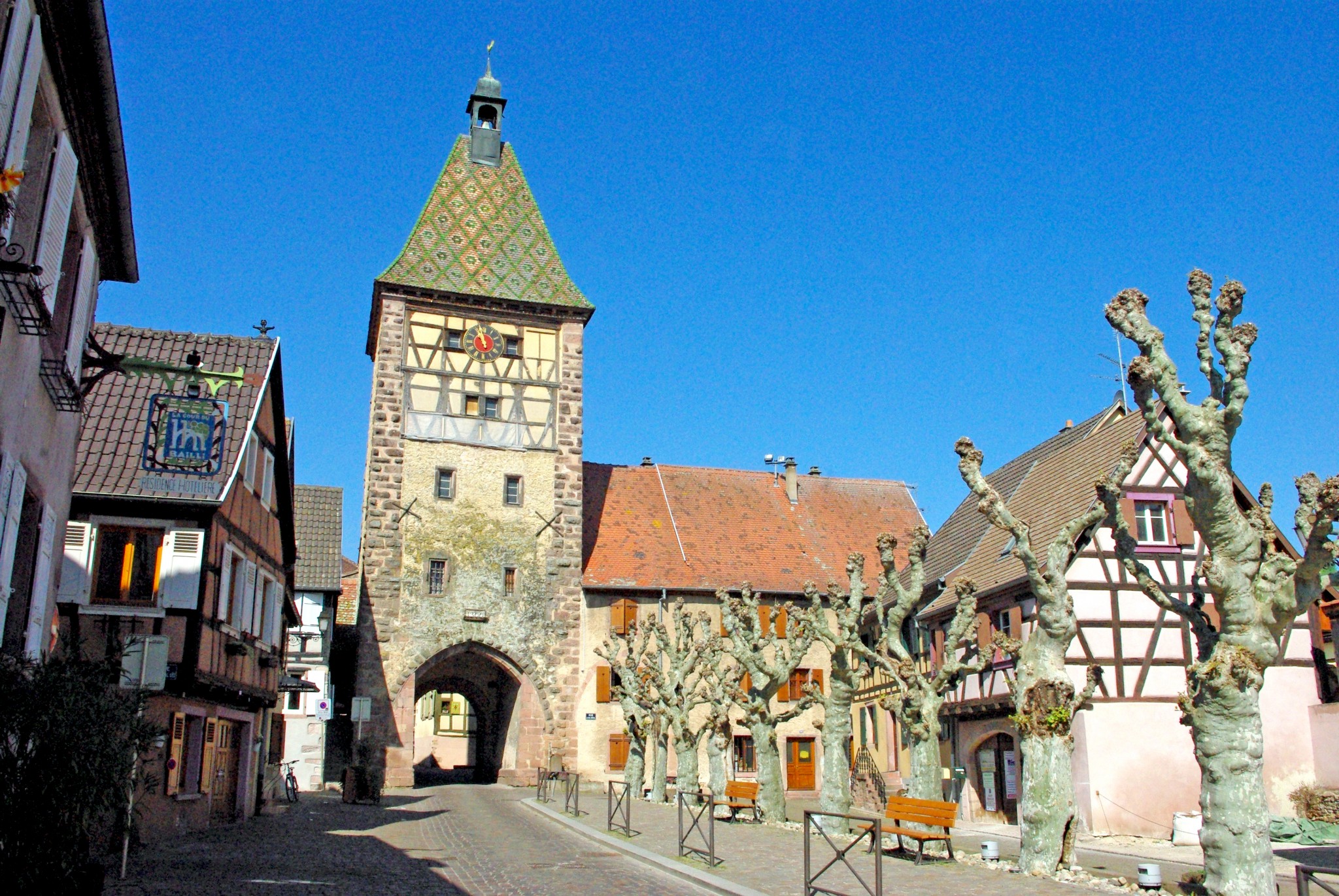
It has the particularity of having a high roof covered with glazed tiles that evoke… Burgundy!
The facade of the countryside appears under rather austere features.
On the other hand, the facade on the city side is more welcoming, with half-timbering.
This characteristic is similar to the famous city gate of Riquewihr, the Dolder.
Notice at the entrance of the gate in the countryside the “Lack’mi” which welcomes visitors since the 16th century by showing them… its charming backside!
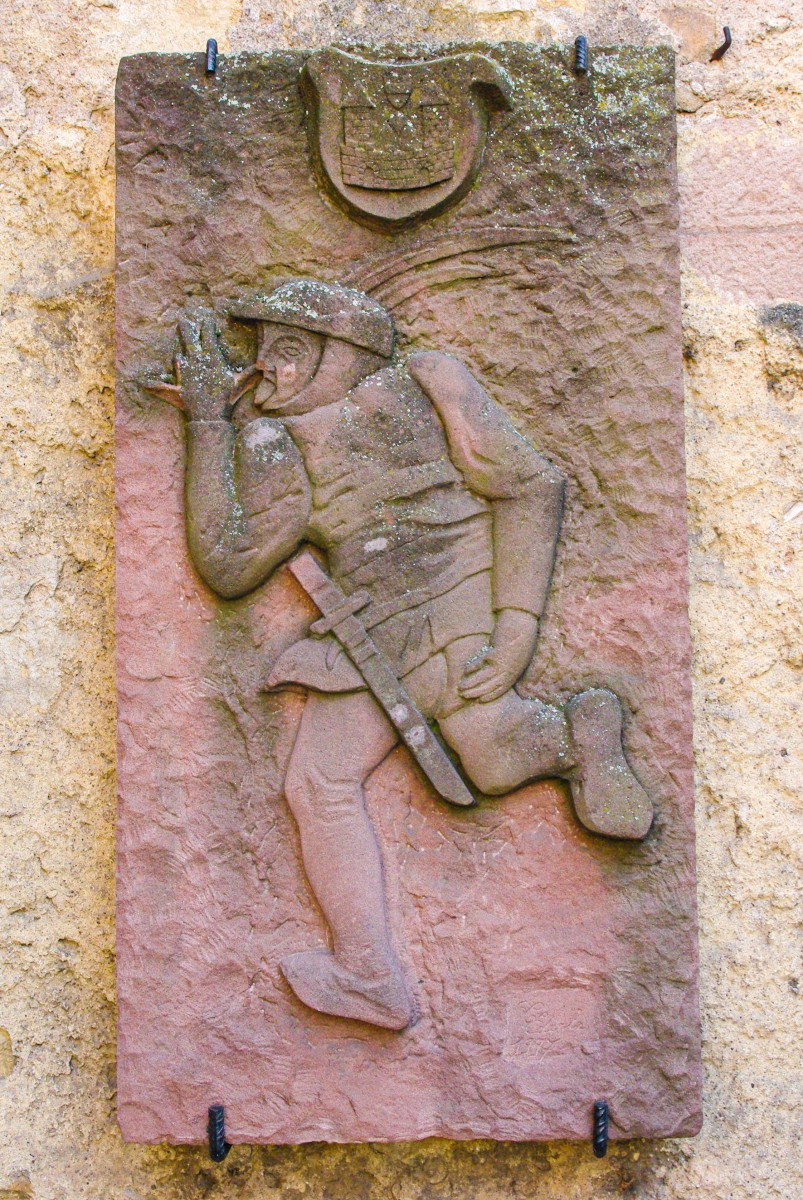
Discover Bergheim on the blog…
Bœrsch
Bœrsch is a very picturesque little town located in the Alsatian vineyards, not far from Obernai.
The historical centre has kept three of the four original fortified doors from the medieval period.
- The Tour Haute (or Obertor) is located south of Bœrsch. Restored in 1908, it presents a fresco by Dietrich of Saint Medard, the parish’s patron saint.
![Fortified City Gates of Alsace - Porte Haute, Bœrsch © Ralph Hammann - licence [CC BY-SA 4.0] from Wikimedia Commons](https://frenchmoments.eu/wp-content/uploads/2021/09/Boersch-Porte-Haute-©-Ralph-Hammann-licence-CC-BY-SA-4.0-from-Wikimedia-Commons.jpg)
![Fortified City Gates of Alsace - Tour Haute, Bœrsch © Ralph Hammann - licence [CC BY-SA 4.0] from Wikimedia Commons](https://frenchmoments.eu/wp-content/uploads/2021/09/Boersch-Tour-Haute-©-Ralph-Hammann-licence-CC-BY-SA-4.0-from-Wikimedia-Commons.jpg)
- The Tour Arrière (or Aftertor) is located to the north. Notice the well nearby, near the staircase leading to the parapet walk.
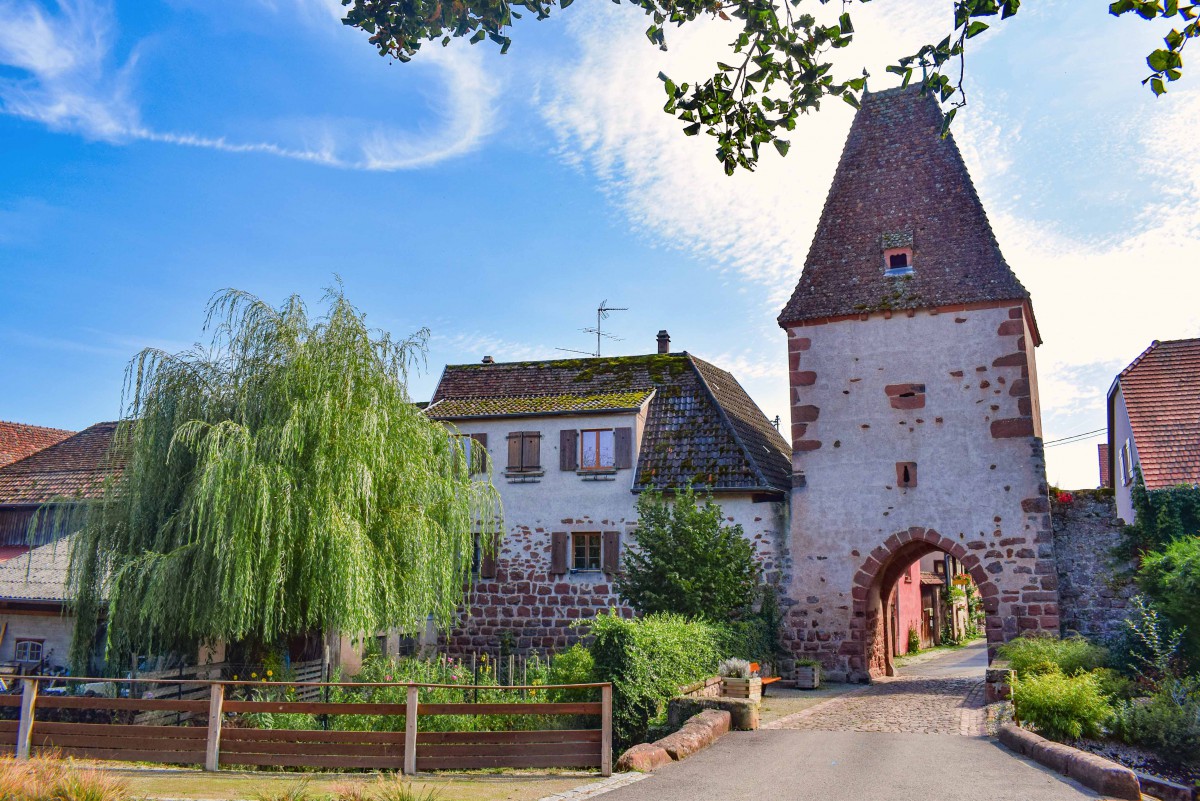
- The Tour Basse (or Niedertor) controlled the western entrance to Bœrsch. It opens onto the vineyard and houses a statue of the Virgin.
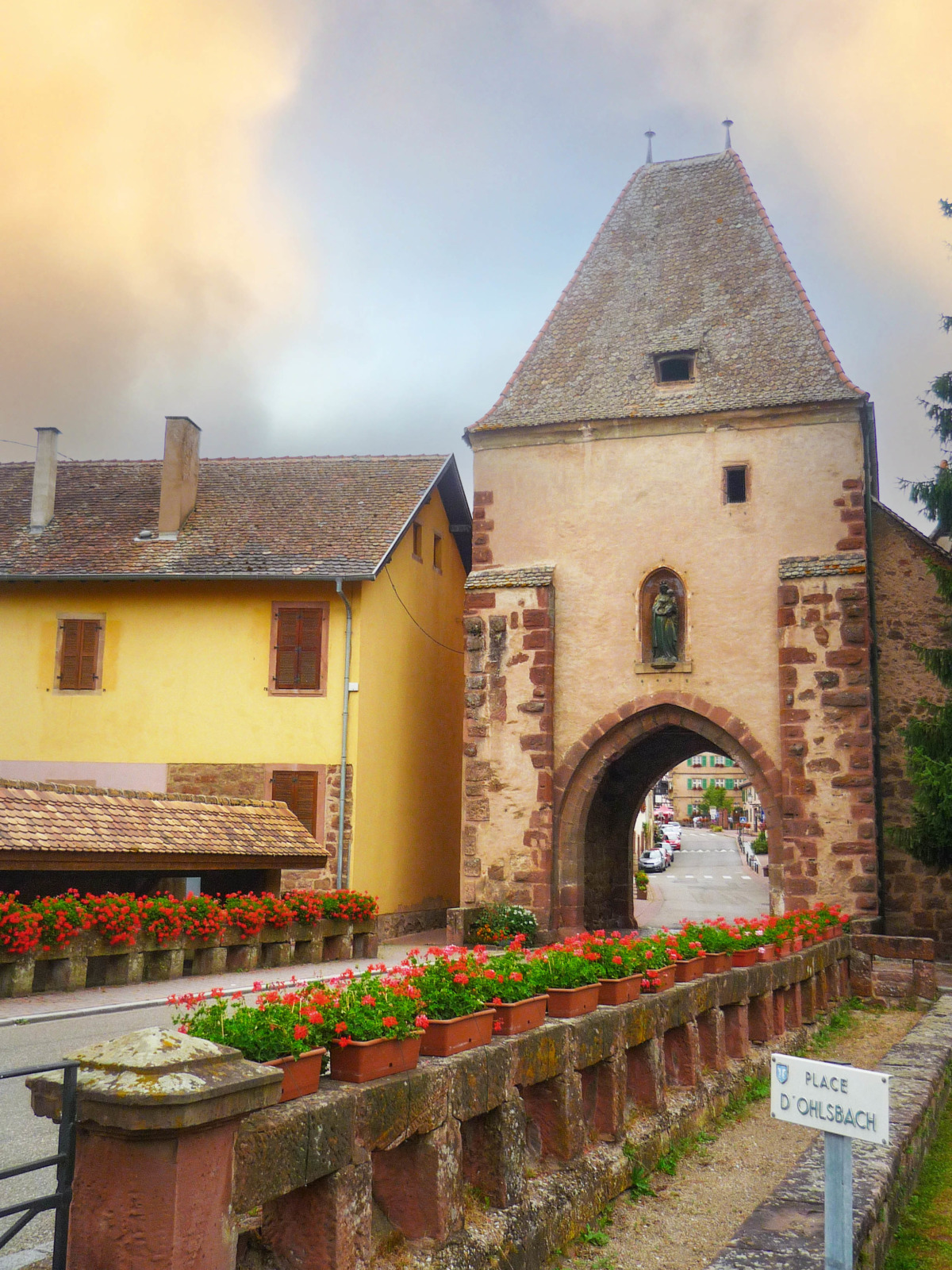
- The fourth gate, the Pfaffentor, was razed in 1758 because it had become dilapidated.
Cernay
Cernay was a fortified town in the Middle Ages. Some vestiges of this period remain the massive and circular southeast corner tower and the Porte de Thann.
The Porte de Thann was part of the fortifications of the city of Cernay since the 13th century.

The tower’s walls are made of rubble stone, and the floors are made of wood panelling.
The loggia on the city side dates from the 16th century.
The fighting of the 1914-18 war severely damaged the town gate and it was restored after 1921.
Nowadays, the Porte de Thann houses the Museum of History and Archaeology.
Its four exhibition rooms present the history of Cernay and its region during the prehistoric, Roman and medieval eras.
Châtenois
Despite its name, the Tour des Sorcières (Witches’ Tower) is a pretty town gate dating from 1432, which was redesigned in its upper part around 1830.
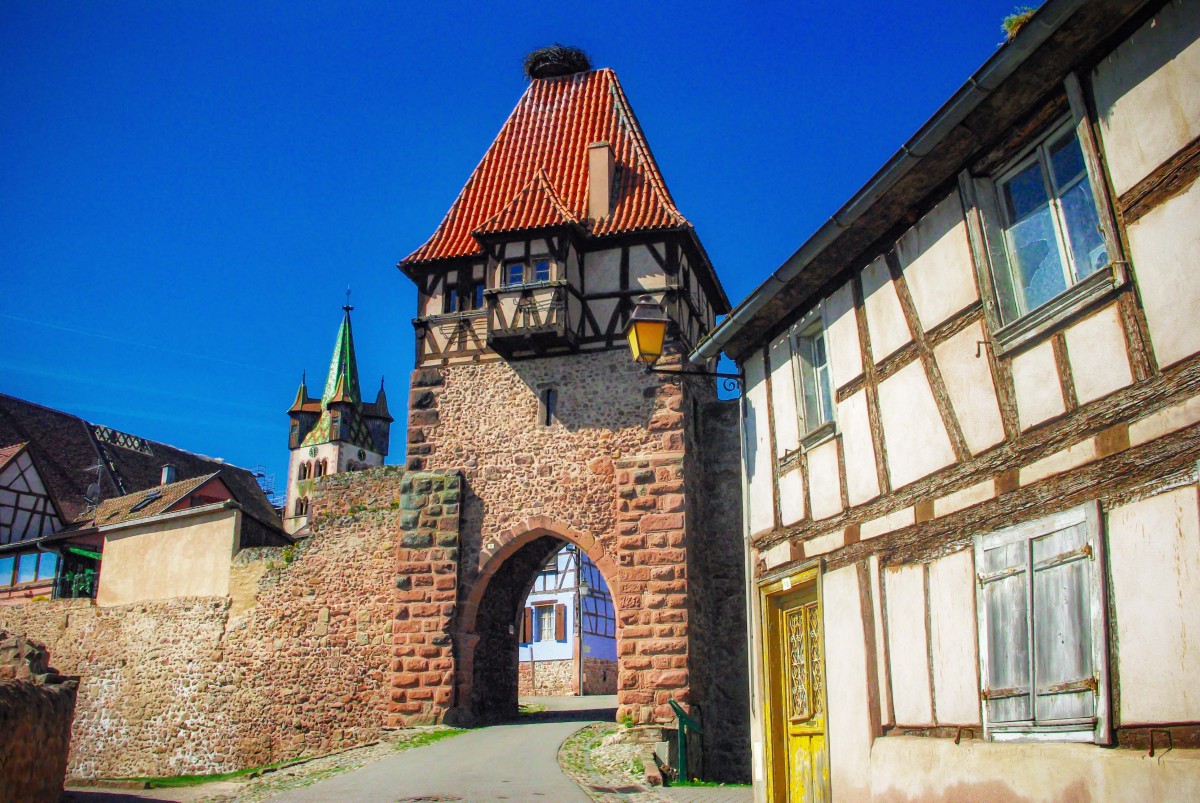
It was given the name “Tour des Sorcières” following the presence of a tower nearby, which served as a dungeon for people accused of witchcraft.
There were seven executions from 1619 to 1629. The sinister building was razed in 1927.
Dachstein
The Porte de la Bruche is located at Dachstein’s northern entrance.
It is part of the remains of the medieval city walls.

Originally, it was located at the level of the walls and allowed access to the village. In the past, the Porte de la Bruche had corners reinforced with rusticated stones.
Dambach-la-Ville
Dambach-la-Ville is a historic town that has retained three town gates.
The construction of the stone rampart of Dambach began in 1323 and was completed during the reign of Berthold II of Bucheck (1328-1353), the bishop of Strasbourg.
Today, three of the four original gates remain:
- The Porte de Blienschwiller (or Grendelthor), built on the site of an old wooden fence (Grendel).

- The Porte d’Ebersheim (or Unterthor) is a granite keep tower. An inscription on the inner side of the gate mentions the date the foundation stone was laid: 12/07/1323.
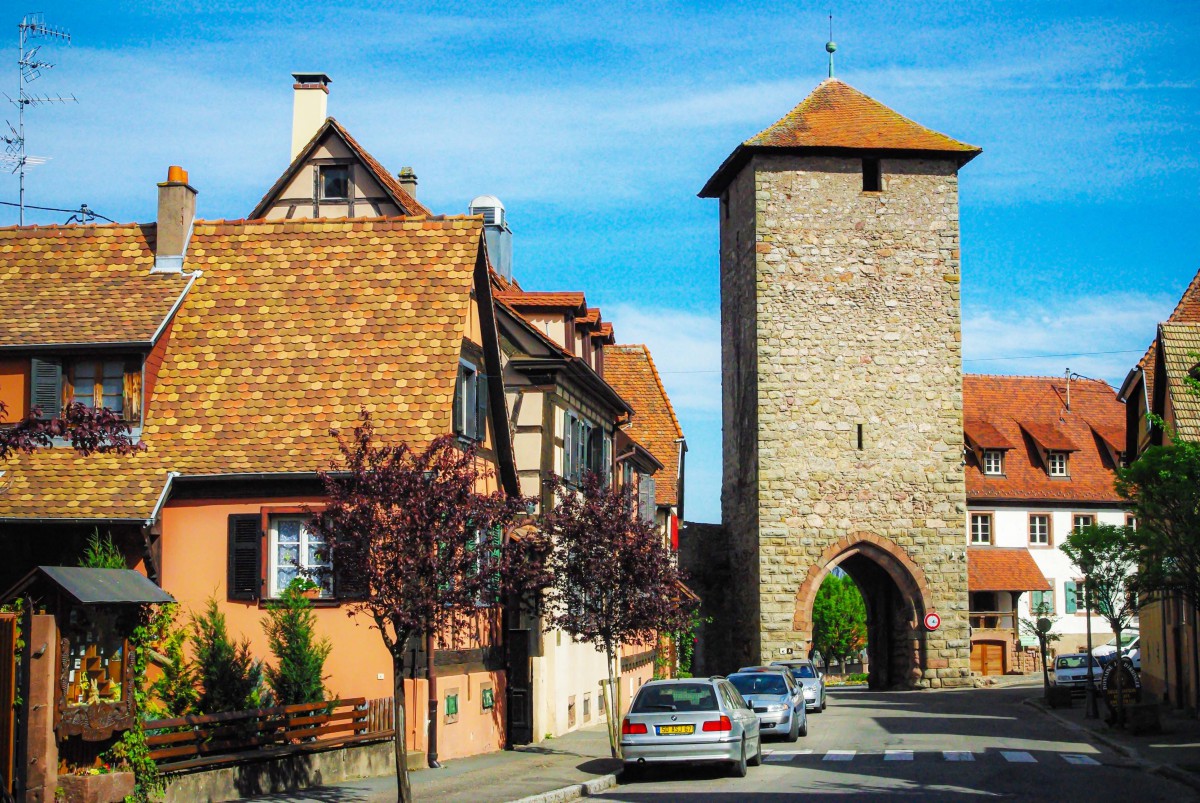
- Finally, the Porte de Dieffenthal (or Neuthor) is the most recent. It was built of granite with a pointed arch of pink sandstone.
![Porte de Dieffenthal, Dambach-la-Ville © Ralph Hammann - licence [CC BY-SA 4.0] from Wikimedia Commons](https://frenchmoments.eu/wp-content/uploads/2021/09/Dambach-la-Ville-Porte-de-Dieffenthal-©-Ralph-Hammann-licence-CC-BY-SA-4.0-from-Wikimedia-Commons.jpg)
- As for the fourth gate (Porte d’Oberthörel), smaller and located to the west, it has since disappeared.
Discover Dambach-la-Ville on the blog…
Guémar
The Porte Haute (or Obertor) dates from 1400 and was part of the rampart of Guémar in the Middle Ages.
![Porte Haute, Guémar © Ralph Hammann – licence [CC BY-SA 4.0] from Wikimedia Commons](https://frenchmoments.eu/wp-content/uploads/2021/09/Porte-Haute-Guémar-©-Ralph-Hammann-licence-CC-BY-SA-4.0-from-Wikimedia-Commons.jpg)
Notice the coat of arms of Guémar (restored in 2009) above the passage and a segment of the wall of the primitive enclosure next to the town gate.
Haguenau
From its medieval past, Haguenau has kept two city gates:
- The Porte de Wissembourg. It is located in the middle of a traffic circle at the crossroads of the Grand’rue, the Boulevard de la Libération, and the Route de Wissembourg. The city gate dates back to the 14th century. It has a rectangular plan made of brick and sandstone with several marks of staining (1574). As its name indicates, the Porte de Wissembourg opened access to the north, in the direction of Wissembourg.
![City gates of Alsace - Haguenau Porte de Wissembourg © GFreihalter - licence [CC BY-SA 3.0] from Wikimedia Commons](https://frenchmoments.eu/wp-content/uploads/2021/09/Haguenau-Porte-de-Wissembourg-©-GFreihalter-licence-CC-BY-SA-3.0-from-Wikimedia-Commons.jpg)
- The Porte des Chevaliers (Knights’ Gate). This square brick city gate, located in front of the city hall, dates from about 1235. After the Middle Ages, it was used as a powder magazine and then as a prison.
![City gates of Alsace - Haguenau Porte des Chevaliers © Globeroutard - licence [CC BY-SA 3.0] from Wikimedia Commons](https://frenchmoments.eu/wp-content/uploads/2021/09/Haguenau-Porte-des-Chevaliers-©-Globeroutard-licence-CC-BY-SA-3.0-from-Wikimedia-Commons.jpg)
Kientzheim
Kientzheim (not to be confused with Kintzheim!) is one of the rare villages in Alsace to have kept its medieval ramparts.
However, only one city gate remains—the 15th-century Porte Basse (or Niedertor).
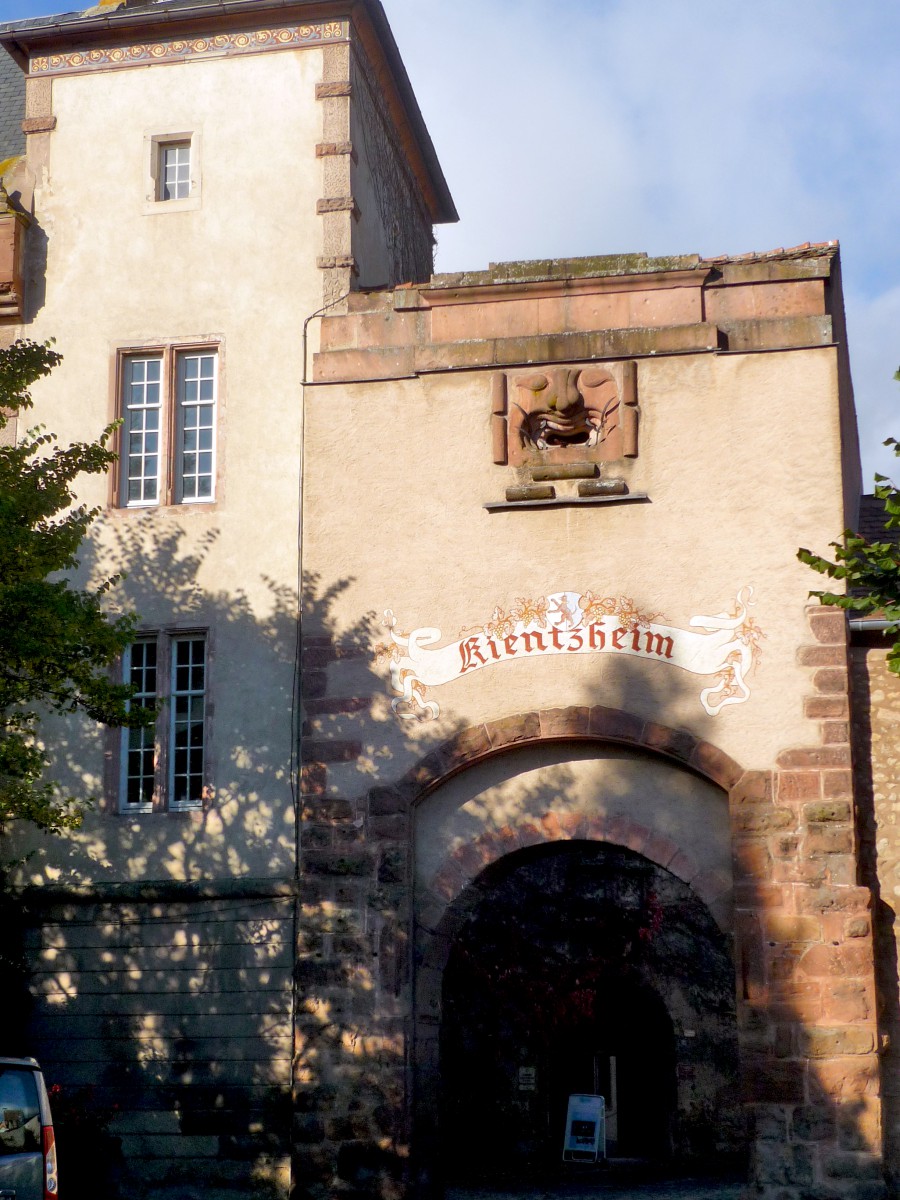
This eastern entrance of Kientzheim is nicknamed the “Porte Lalli“.
The reason is quite anecdotal. Observe the loophole in the upper part of the door in the shape of a grinning mouth.
This stone figure sticks out its tongue (itself metallic!).
It was said that the Lalli was meant for the city’s enemies, but the Kientzheimers say it only makes a face to those who look at it!

Discover Kientzheim on the blog…
Lauterbourg
The Porte de Landau in Lauterbourg does not date from the Middle Ages, even if it stands on the site of the old medieval ramparts.
Like the Porte de Brisach in Belfort, it dates from the Vauban period (1708) and was part of a system of fortifications designed to protect the borders of the Kingdom of France against possible enemy attacks.
![Porte de Landau, Lauterbourg © peter schmelzle – licence [CC BY-SA 3.0] from Wikimedia Commons](https://frenchmoments.eu/wp-content/uploads/2021/09/Lauterbourg-Porte-de-Landau-©-peter-schmelzle-licence-CC-BY-SA-3.0-from-Wikimedia-Commons.jpg)
Observe the sun carved on one side of the gate.
It reminds us of the oath of allegiance taken to the King of France in 1680.
The exhibition room on the first floor houses a model of the fortifications of Lauterbourg, according to the plans of 1782.
Molsheim
The Porte des Forgerons (Blacksmith’s Gate or Schmiedtor) dates from 1250-1260 when Molsheim was surrounded by ramparts.
It is the only surviving city gate; the other gates were destroyed in the 19th century.
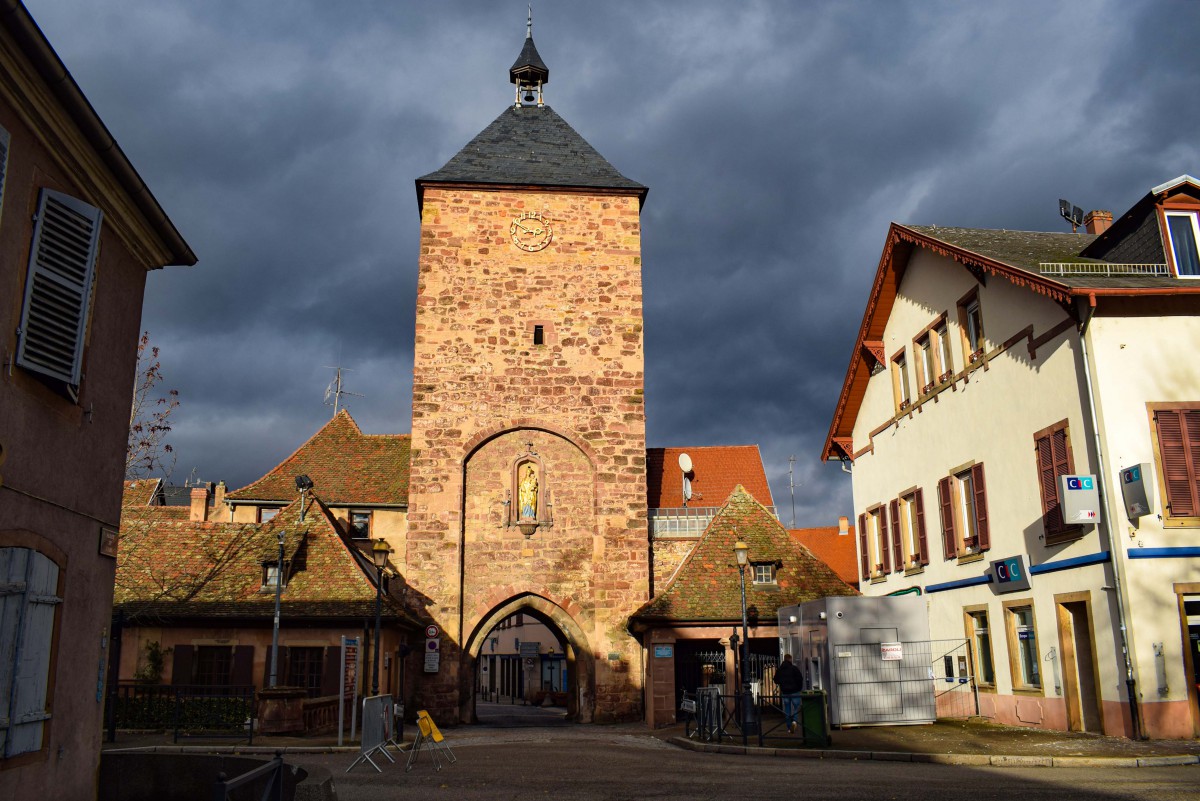
The tower has a square plan and a door with a pointed arch. It has four floors and a four-sided roof.
Finally, at the top is a bell tower housing a small bell.
Observe the statue of the Virgin and Child in the countryside of the gate.
Two metres high and weighing 500 kg, it is made of cast iron gilded with gold leaf.
It was donated by the bourgeoisie of Molsheim (1868).
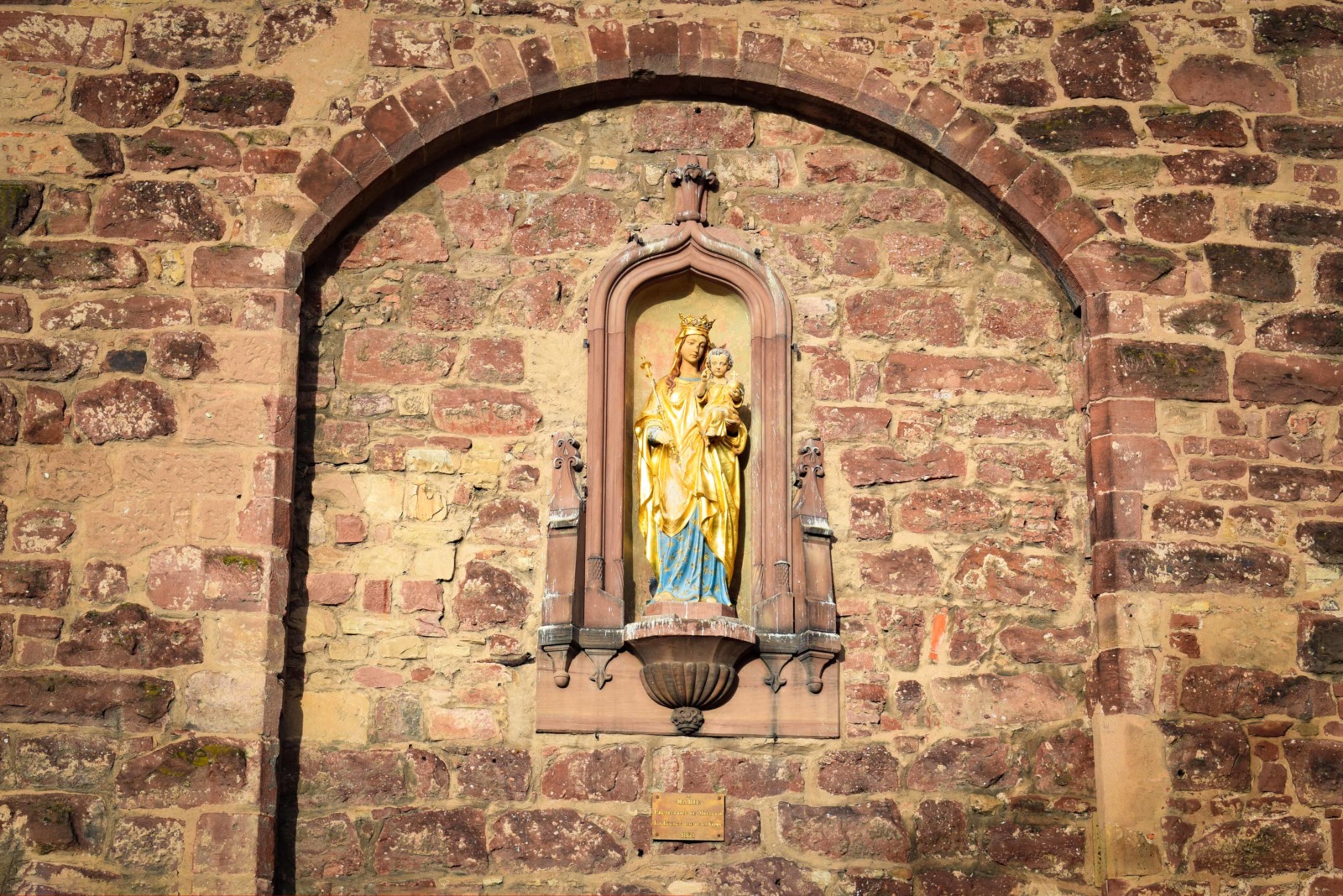
Mutzig
The Porte de Strasbourg (or Porte Saint-Maurice) opened access to the city from the west (the road to Strasbourg).
It was part of the fortifications of Mutzig, and two other city gates, which have now disappeared, also opened access to the city from the west.
The Strasbourg Gate dates back to the end of the 13th century (or the beginning of the 14th century)
![City gates of Alsace - Mutzig - Porte de Strasbourg © Ralph Hammann - licence [CC BY-SA 4.0] from Wikimedia Commons](https://frenchmoments.eu/wp-content/uploads/2021/09/Mutzig-Porte-de-Strasbourg-©-Ralph-Hammann-licence-CC-BY-SA-4.0-from-Wikimedia-Commons.jpg)
The upper part is an addition from 1550, and the roof dates from the 17th century.
The second floor was used as a prison until the end of the First World War.
On the countryside side, admire the painting representing Saint-Maurice.
![City gates of Alsace - Mutzig - Porte de Strasbourg © Ralph Hammann - licence [CC BY-SA 4.0] from Wikimedia Commons](https://frenchmoments.eu/wp-content/uploads/2021/09/Mutzig-Porte-de-Strasbourg-02-©-Ralph-Hammann-licence-CC-BY-SA-4.0-from-Wikimedia-Commons.jpg)
Neuf-Brisach
The fortified town of Neuf-Brisach was created ex nihilo in 1697 in the Alsace plain, opposite VBreisach-am-Rhein, in Germany.
It is the only illustration of the “third system” of Vauban. King Louis XIV chose the octagonal plan of the new city out of three projects submitted by Vauban.
Since 2008, Neuf-Brisach has been a member of the network of major Vauban sites listed as a UNESCO World Heritage Site.
![Neuf-Brisach from above © Luftfahrer – licence [CC BY-SA 3.0] from Wikimedia Commons](https://frenchmoments.eu/wp-content/uploads/2021/09/Neuf-Brisach-vu-du-ciel-©-Luftfahrer-licence-CC-BY-SA-3.0-from-Wikimedia-Commons.jpg)
The access to the fortress of Neuf-Brisach is made through three carriage gates:
- the Porte de Colmar (to the northwest),
- the Porte de Strasbourg (to the north-east)
- and the Porte de Bâle (to the southeast).
- The Porte de Belfort (southwest) is exclusively pedestrian.
Two gates are worth a visit:
- The Porte de Colmar gives access to the city through a tunnel that passes under a vaulted vestibule. The first floor housed the police station, the guardhouse of the officer on duty and a prison. The second floor had an apartment for a staff officer.
![Fortified City Gates of Alsace - Porte de Colmar, Neuf-Brisach © Gzen92 - licence [CC BY-SA 4.0] from Wikimedia Commons](https://frenchmoments.eu/wp-content/uploads/2021/09/Neuf-Brisach-Porte-de-Colmar-©-Gzen92-licence-CC-BY-SA-4.0-from-Wikimedia-Commons.jpg)
- The Porte de Belfort (1700) houses the Vauban Museum on the first floor, created in 1957.

Ribeauvillé
In the Middle Ages, Ribeauvillé was divided into four independent districts, each accessible through a city gate.
Of the four doors, only one remains today: the Tour des Bouchers (Tower of the Butchers).
It allowed passage between the old town and the middle town.

The tower owes its name to the butchery activities in the district.
The city gate dates back to 1287 and originally consisted of three floors.
It was heightened in 1536 and successively used as a watchtower, a belfry, and a prison.
In 1803, the pavilion roof was destroyed by fire, which led the municipality to consider demolishing the tower.
The tower was a hindrance to the carriage traffic along the Grande Rue.

Look (with binoculars!) at the gargoyles on both sides of the tower and at the top.
You will see men grimacing, a lion and a madman carrying coats of arms (those of the Ribeaupierre and Furstenberg families).
You will also notice the Ribeaupierre coat of arms on the east, west and north sides of the upper railing (with the collar of the Golden Fleece).
Discover Ribeauvillé on the blog…
Riquewihr
The first fortified enclosure of Riquewihr dates from 1291.
Many vestiges remain, including two city gates: the Obertor and the magnificent Dolder.
The Dolder
Seen from the rue du Général de Gaulle, the Dolder is sublime with its timber-framed and corbelled floors. 25 meters high, it is the emblematic monument of Riquewihr.
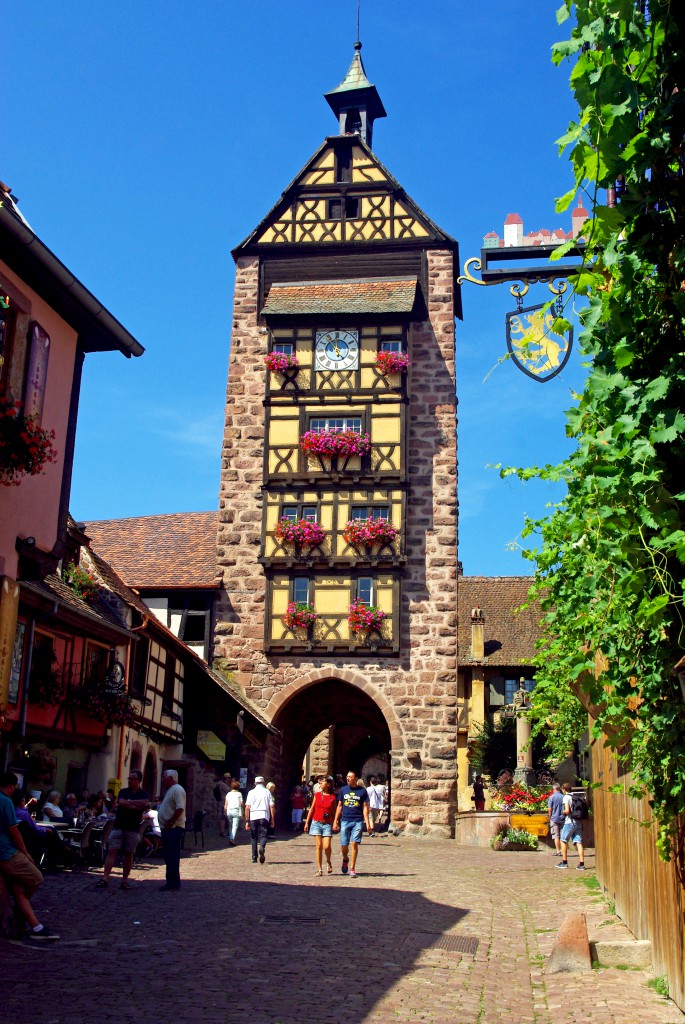
Built in 1291, the Dolder is also the upper entrance door, a watchtower, and a belfry.
The facade on the town side is very picturesque, with its half-timbering.
The guard’s family occupied its four floors.
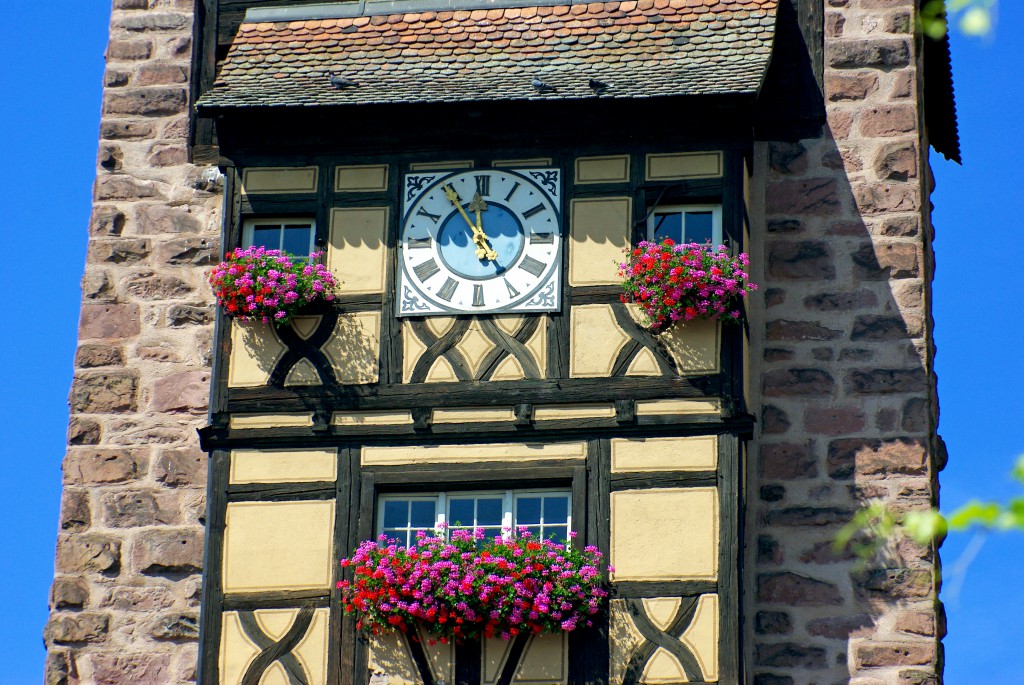
The façade in the countryside appears much more austere.
This entrance to the city was indeed meant to impress the enemies.
The small bell at the top of the tower allowed the guard to warn the population of imminent danger.
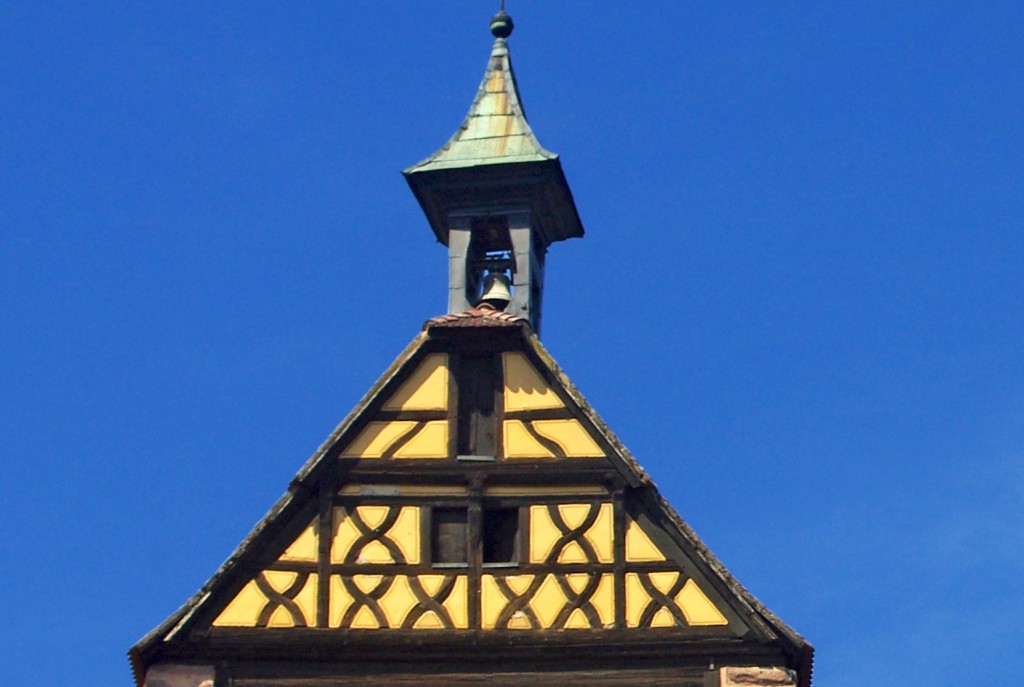
Inside the tower is the small Dolder Museum with weapons and other ancient objects.
The Porte Haute
Once you have passed under the Dolder, another fortified gate closes the access to the village to the west: the Obertor (or High Gate).
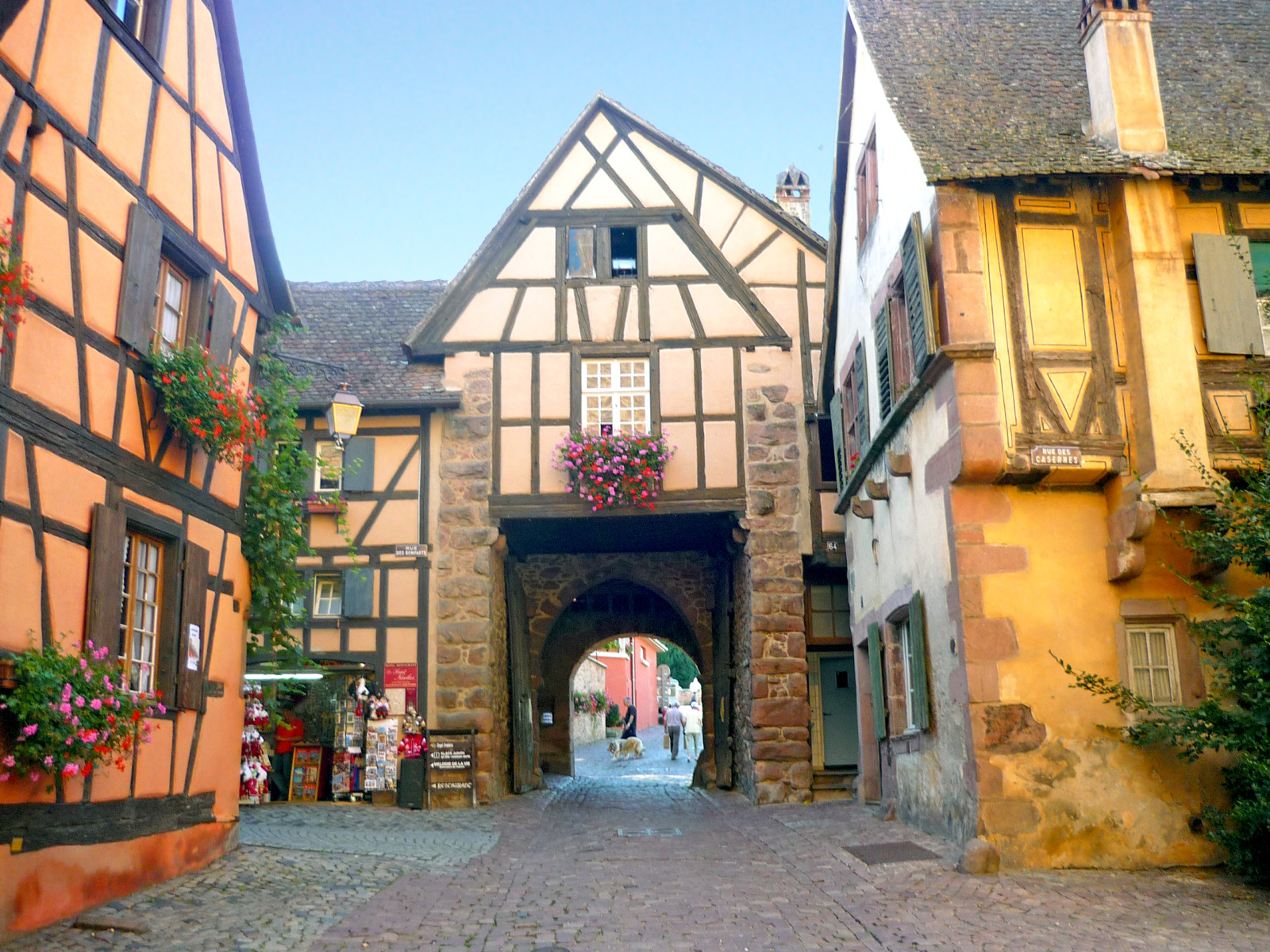
It dates from 1500 and was intended to reinforce the second city wall, built to respond to the development of firearms.
Notice its portcullis (one of the oldest in Europe!) and the place of the old drawbridge.
Discover Riquewihr on the blog…
Rosheim
Rosheim, an ancient city member of the Alsatian Decapolis, has kept four city gates and many remains of its ramparts. Two series of walls surrounded the town in the Middle Ages:
- The inner rampart (13th century) which surrounded the Mittelstadt. There are two city gates: the Porte de l’Hôtel de Ville and the Porte de l’Ecole, as well as a corner tower.
- The outer rampart (second half of the 14th century) consisted of three gates and eight towers. Only the Porte du Vierge, the Porte du Lion and some ruined towers remain.
The four city gates of Rosheim are :
- The Porte de l’Hôtel de Ville (or Zittgloeckeltor). It is located in the extension of the town hall.

- The Porte de l’Ecole (or Hohenbourg), the former Middle Gate (or Mitteltor) which surrounds the Hohenbourg school.

- The Porte de la Vierge (or Low Gate or Niedertor).

- And in the north of the city, the Porte du Lion.
![Fortified City Gates of Alsace - Porte du Lion, Rosheim © Ralph Hammann - licence [CC BY-SA 4.0] from Wikimedia Commons](https://frenchmoments.eu/wp-content/uploads/2021/09/Rosheim-Porte-du-Lion-©-Ralph-Hammann-licence-CC-BY-SA-4.0-from-Wikimedia-Commons.jpg)
Sélestat
After Strasbourg and Colmar, Sélestat ranks third in Alsace for its rich heritage.
The former member of the Alsatian Decapolis has preserved three city gates: the Tour de l’Horloge (Clock Tower) and the Tour des Sorcières (Witches Tower), both from the Middle Ages and the Porte de Strasbourg from the 17th century.
The Tour de l’Horloge
The Tour de l’Horloge (or Tour Neuve) was one of the main fortified entrances to the city.
It opens onto the Rue des Chevaliers.
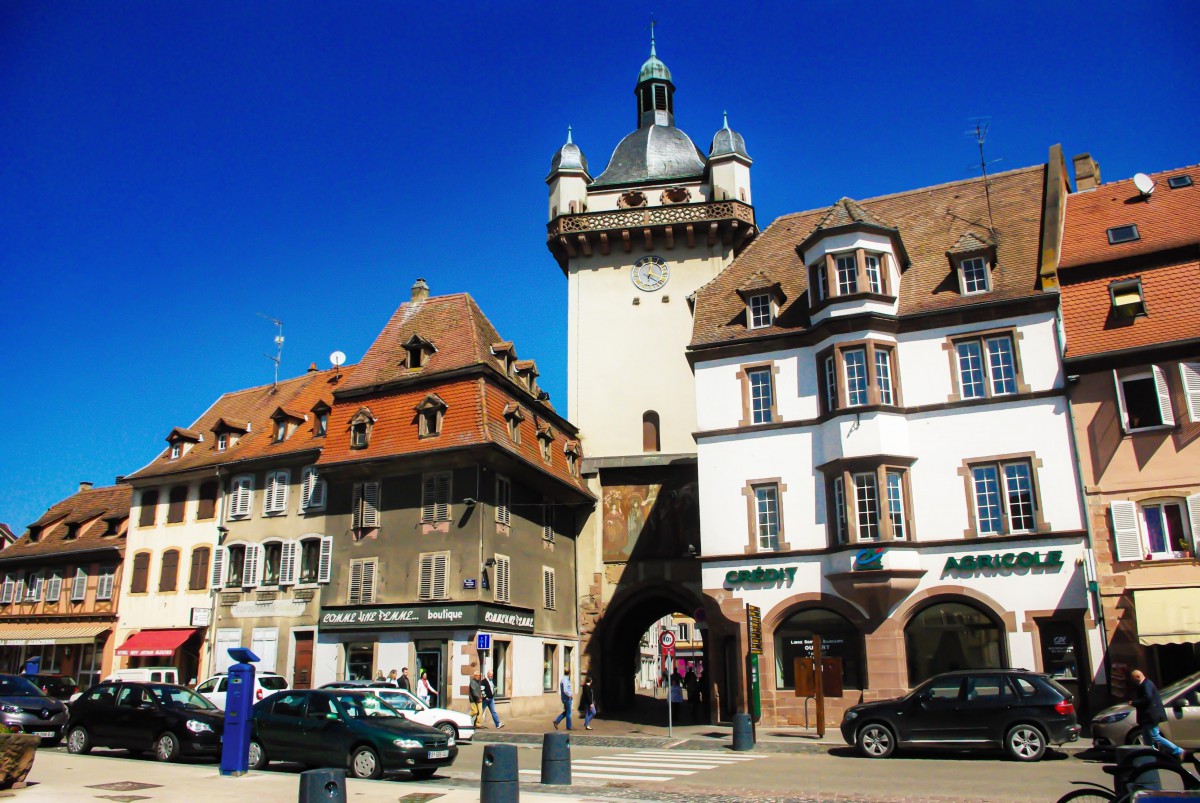
Built in the 13th century, it was significantly modified in the 17th century.
In 1614, it was topped with a bulbous roof and watchtowers, all topped with a lantern.
The fresco that can be seen from the rue du Président Poincaré represents the crucifixion.
Two other frescoes under the tower allude to the powerful guilds that governed Selestadian activity: butchers, tanners, and winegrowers…
The Tour des Sorcières
This gloomy name corresponds to a tower dating from the 13th century. Its original name, the “Niedertor”, means the low door.
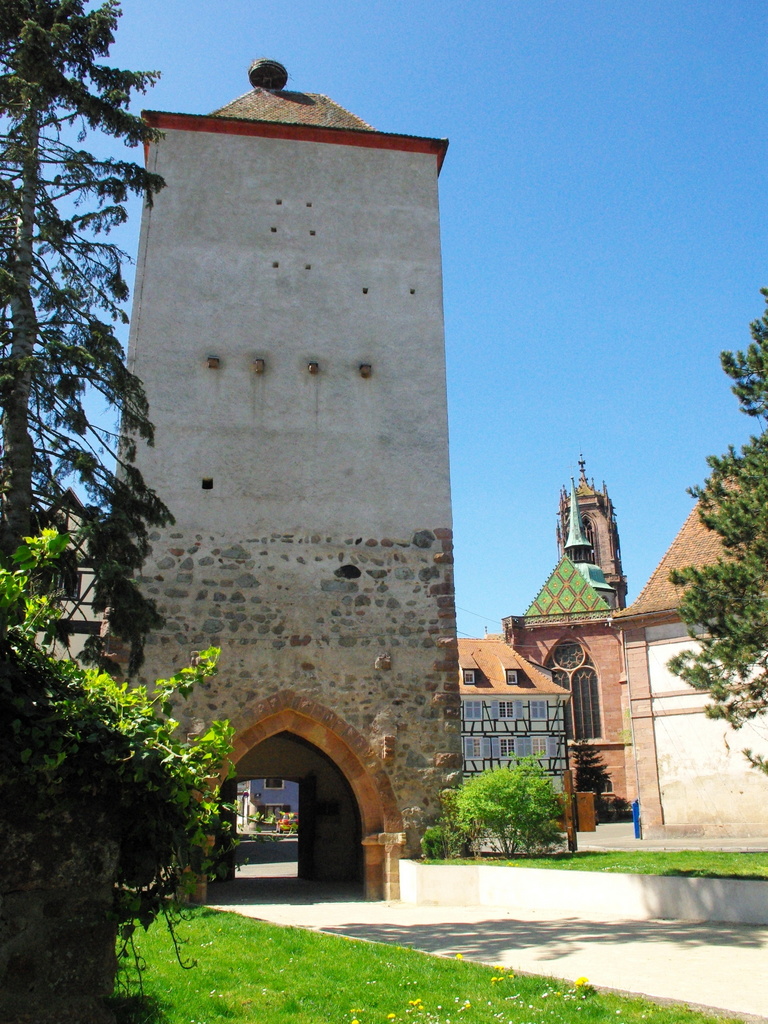
The Witches’ Tower guarded the access to the city against the north.
In the 17th century, the arcades on the first floor were walled up to lock up women accused of witchcraft.
The Porte de Strasbourg
Located near the Tour des Sorcières, the Porte de Strasbourg was built from 1679 to 1681.
It was an integral part of the Vauban enclosure, and it is the only one of the three original gates of the Vauban system that remains today.
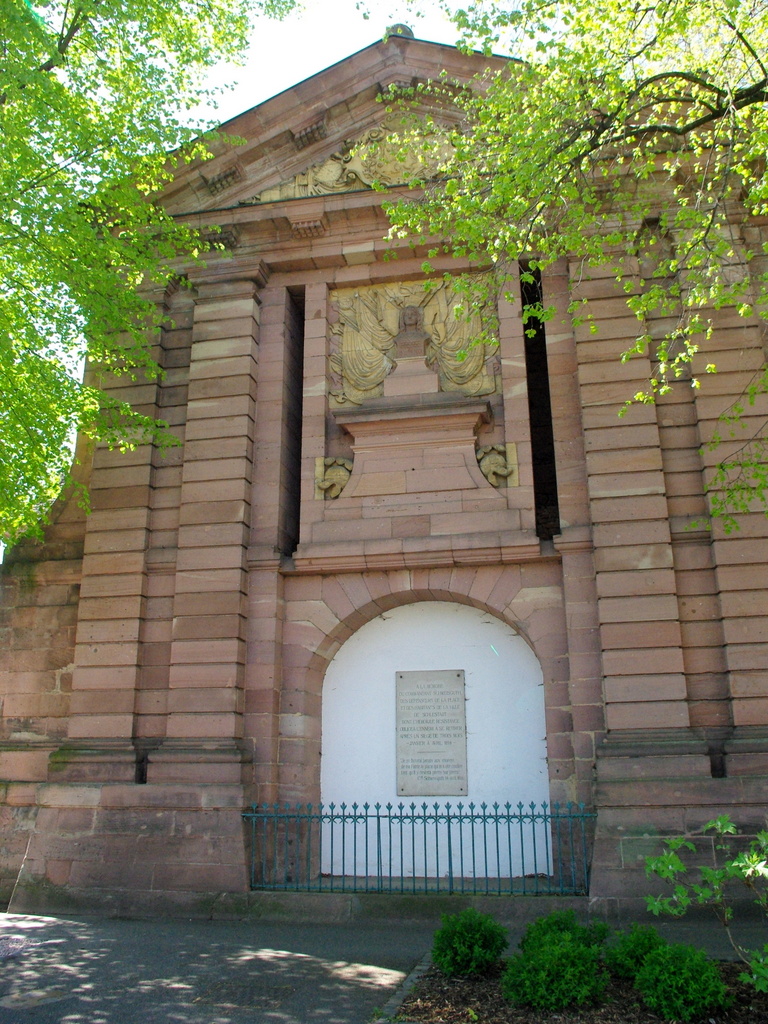
Look at the outward-facing façade: it is much more decorated than its reverse.
In addition to the many symbols of the army, there is the lion of the Sélestat coat of arms and the archangel Saint-Michel (patron saint of soldiers and soldiers).
You will find three fleurs-de-lis above the lion – the mark of the kingdom of France.
Notice the bust of Marianne in the central space of the door (a symbol of the French Republic).
Before the Revolution, there was a bust of Louis XIV. The interior facade is less pompous and looks like a small private mansion.
Discover Sélestat on the blog…
Strasbourg
Few vestiges remain of Strasbourg‘s medieval fortifications.
The famous Covered Bridges of the 13th century are the symbol.
However, Strasbourg has a city gate that dates from the same period (around 1200-1250): the Porte de l’Hôpital (or Spitaltor).
![City gates of Alsace - Strasbourg - Porte de l'Hôpital © Ji-Elle - licence [CC BY-SA 3.0] from Wikimedia Commons](https://frenchmoments.eu/wp-content/uploads/2021/09/Strasbourg-Porte-de-lHôpital-©-Ji-Elle-licence-CC-BY-SA-3.0-from-Wikimedia-Commons.jpg)
This defensive tower gate was closed and opened morning and evening by the Franc-Bourgeois, then by the tailors.
The gate was significantly modified in the 17th century with the addition of a lantern to serve as an observatory.
It is now part of the Strasbourg Civil Hospital complex, hence its name.
Observe the facade in the countryside, which presents a painting of the 14th century.
It is a crucifixion where the pain of Mary is represented by a sword in the heart.
Discover Strasbourg old town on the blog…
Turckheim
In the 14th century, following the adhesion of Turckheim to the Alsatian Decapolis, the imperial Free City was fortified.
The historical city has kept three fortified gates:
The Porte de France
The Porte de France (Niedertor) is a massive quadrangular tower whose lower parts date back to 1330.
It was probably equipped with a drawbridge and a portcullis, which have since disappeared. At the top, there is a stork’s nest.
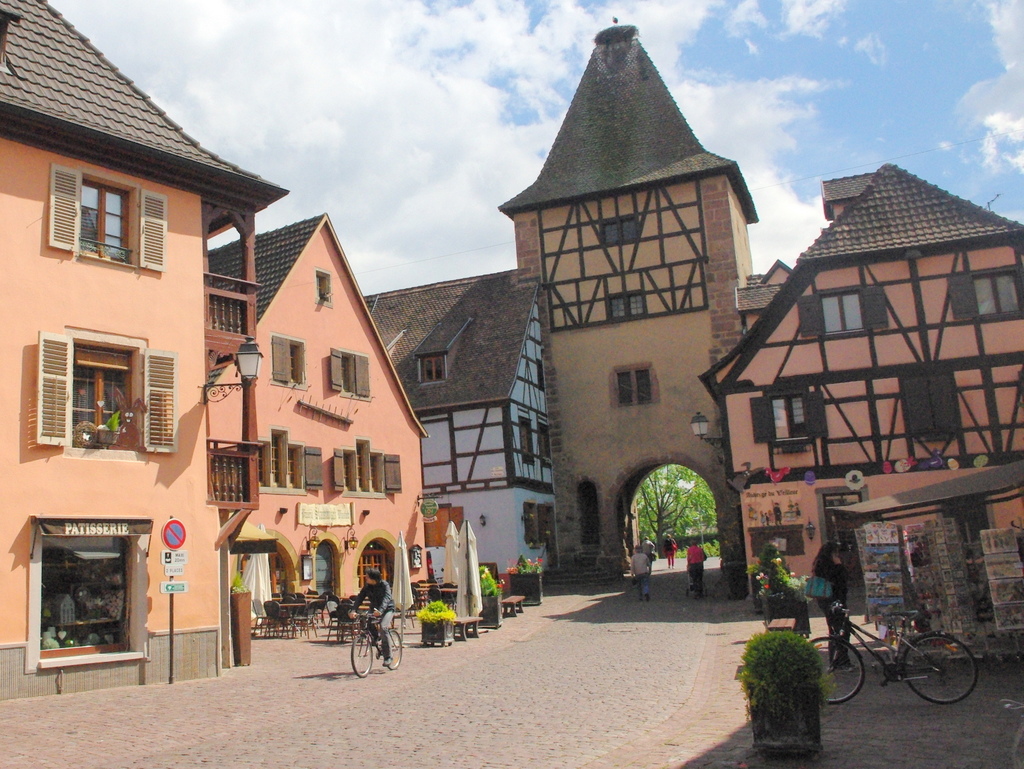
The gate opened access to the south of Alsace and to Switzerland, and more particularly to foreign trade with “the foreigner.”
The guard was in charge of closing the two doors after the evening angelus. The next day, he reopened them in the morning Angelus.
Traditionally, the door remained closed on Sundays until the end of mass.
The Porte de Munster
The Porte de Munster (Obertor) dates from the 14th century and opened access to the valley of Munster and beyond by the Schlucht pass to Lorraine.

Look at the windows: they are decorated with scallops, which means that it was located on the way to Santiago de Compostela.
However, the door was associated with the sad fate of 26 women accused of witchcraft between 1572 and 1626.
Hence its nickname of “Door of Sorrows”.
It was from the Munster Gate that they left the city to reach the place called Wann, where they were burned alive.
Later, in 1675, it was through this gate that Marshal Turenne and his army entered Turckheim.
Finally, the small bell at the top of the bell tower was used to give an alert in case of a storm. It is still intact.
The Porte de Brand
The Porte de Brand (Öltor) is the most defensive of the three gates of Turckheim.
It is thus the most austere. Massive and without particular decoration, the gate was equipped with a portcullis and a drawbridge crossing a ditch which is still visible today.
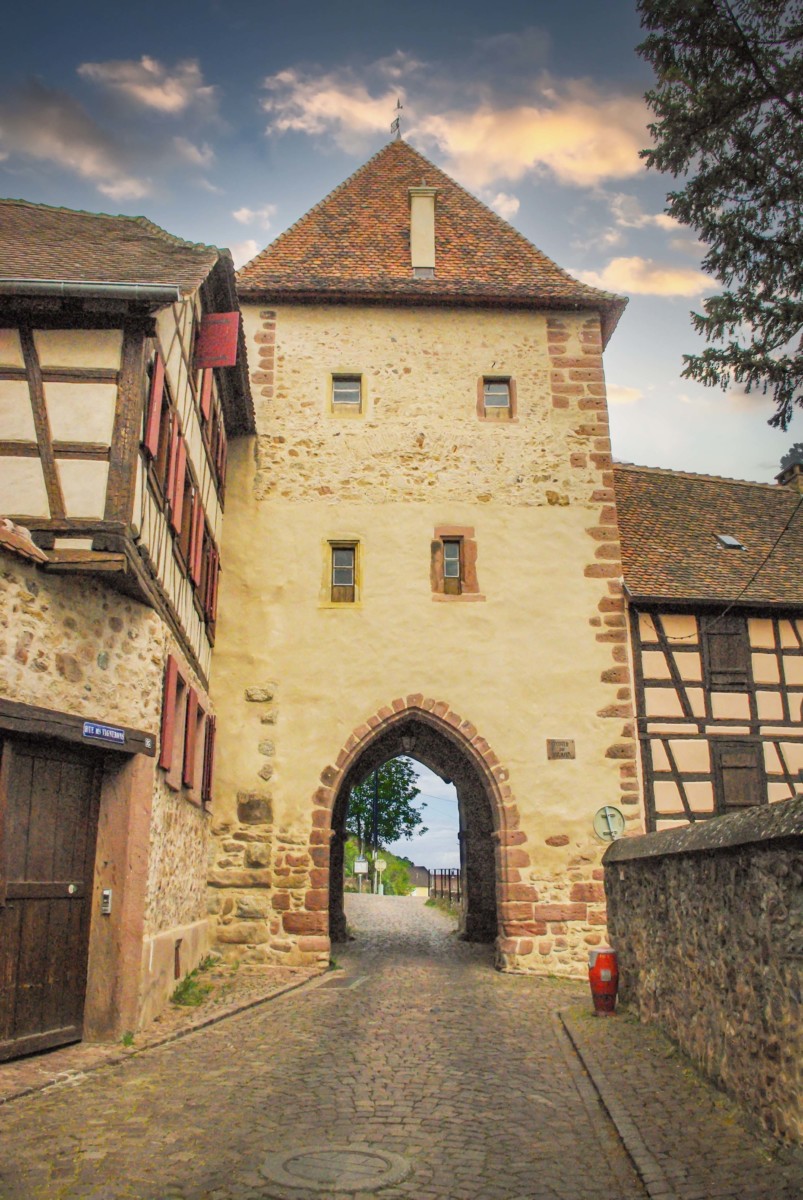
The building owes its name to the Brand vineyard to which it gives access.
During the grape harvest, its swing doors were left exceptionally open.
In 1850, it escaped demolition thanks to the mobilization of the inhabitants.
Discover Turckheim on the blog…
Wangen
Wangen is a charming Alsatian village located north of the Alsace Wine Route.
The village’s old fortifications originally included three gates: the Niedertor, the Sommertor, and the Motscheltor. The latter was destroyed in 1887.
The Porte Basse (or Niedertor)
This is the most beautiful gate in the village and dates back to the end of the 13th century.
Until the 17th century, a moat 15 meters wide and 6 meters deep defended the access.

The gate was initially closed by two wooden doors (no portcullis).
Note the brattice above the gate.
The Porte du Sud (or Sommertor / Sondertor)
This gate, located at the southeast end of the enclosure, was remodelled in the 16th and 17th centuries.
If you look closely, you can see the traces of the hinges, the doors, and the old drawbridge.
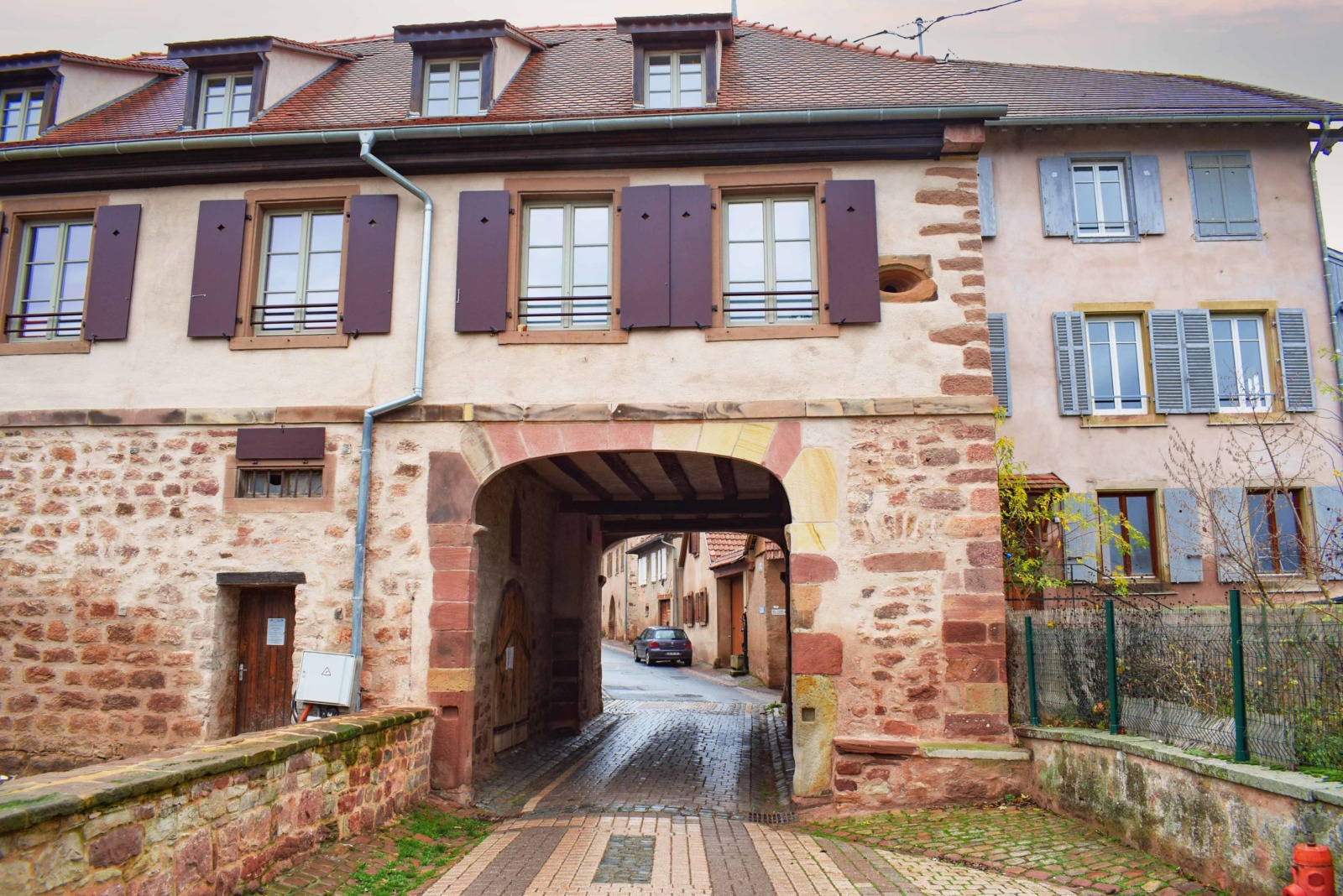
In the countryside side, one can also see the two 16th-century loopholes with redans.
Wasselonne
The Tour du Château (Castle Tower) in Wasselonne is not exactly a city gate, as it was the entrance gate to the castle, which has now disappeared.
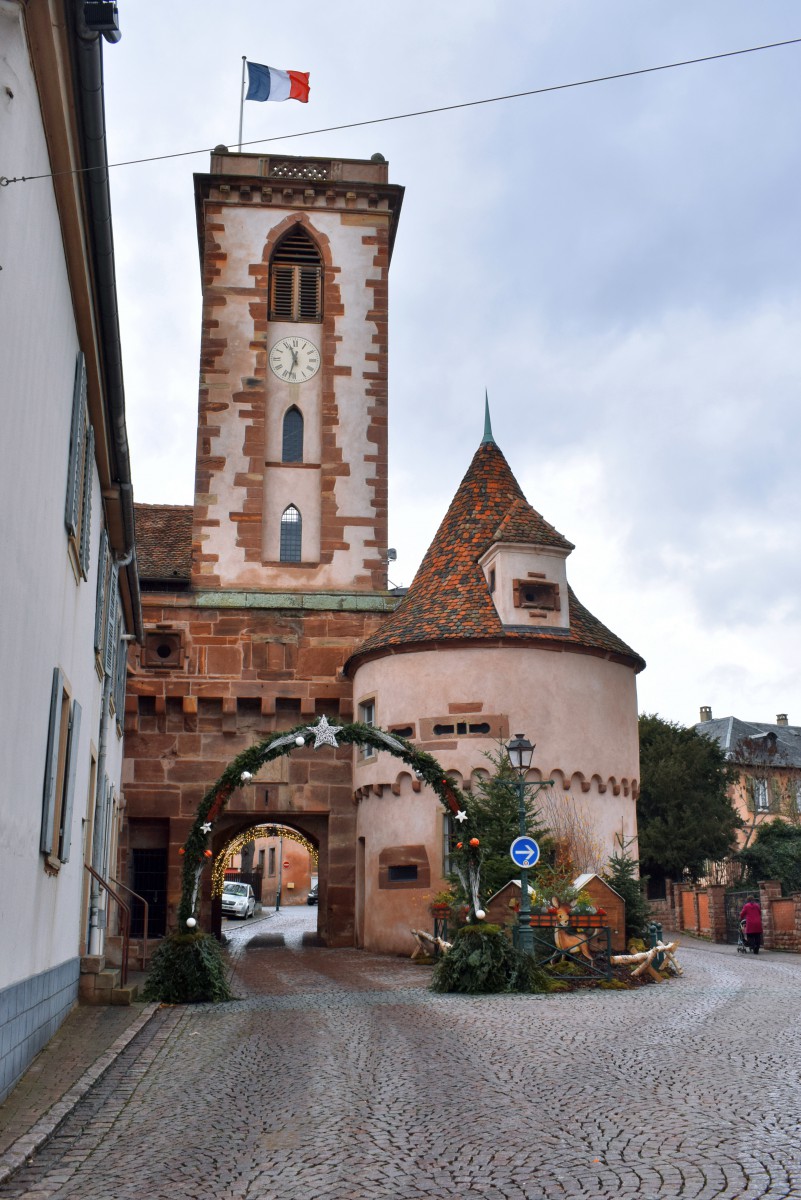
In the Middle Ages, a castle flanked by 27 towers defended the city of Wasselonne.
It was one of the most important fortresses in Lower Alsace at that time.
Some remains of the castle remain, including the round towers and the famous “Tour du Château,” which marked the entrance.
Two round turrets frame the gate tower.
The square tower itself is an addition from 1789.
It replaced the old watchtower that stood in the centre of the castle until 1674.
The lower part housed the guard’s quarters and cells for prisoners.
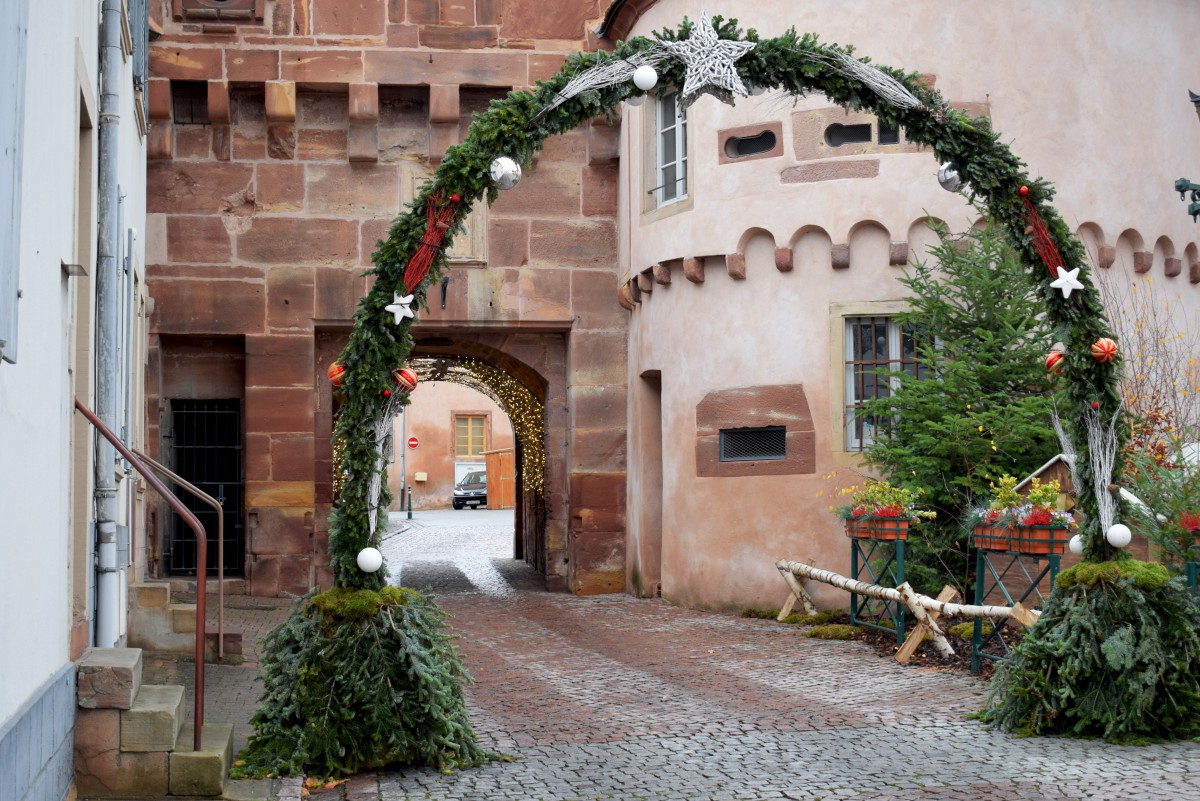
A small anecdote: the tower contains a 760 kg bell from 1818 and a clock mechanism from 1881.
Wihr-au-Val
A fortified gate of rectangular plan marks the entrance of the village of Wihr-au-Val: the Untertor.
Its construction dates back to 1303 when Wihr-au-Val was fortified.
![City gates of Alsace - Wihr-au-Val - Untertor © Madaki - licence [CC BY 2.5] from Wikimedia Commons](https://frenchmoments.eu/wp-content/uploads/2021/09/Wihr-au-Val-Untertor-©-Madaki-licence-CC-BY-2.5-from-Wikimedia-Commons.jpg)
The present first-floor dates from the Middle Ages.
The upper parts suffered severely from the bombings of June 18, 1940, and restoration was undertaken between 1958 and 1960.
Find out more about the city gates of Alsace…
- My guide of the half-timbered houses of Alsace
- Discover the region of Alsace
- The most beautiful Renaissance houses in Alsace
- Read more about the city gates in Europe on Wikipedia
Other city gates articles to read on our French blog Mon Grand-Est:
- Les portes fortifiées d’Alsace
- Les portes de ville de Nancy
- La porte des Allemands à Metz
- L’Altpörtel de Spire en Allemagne
Pin on Pinterest!
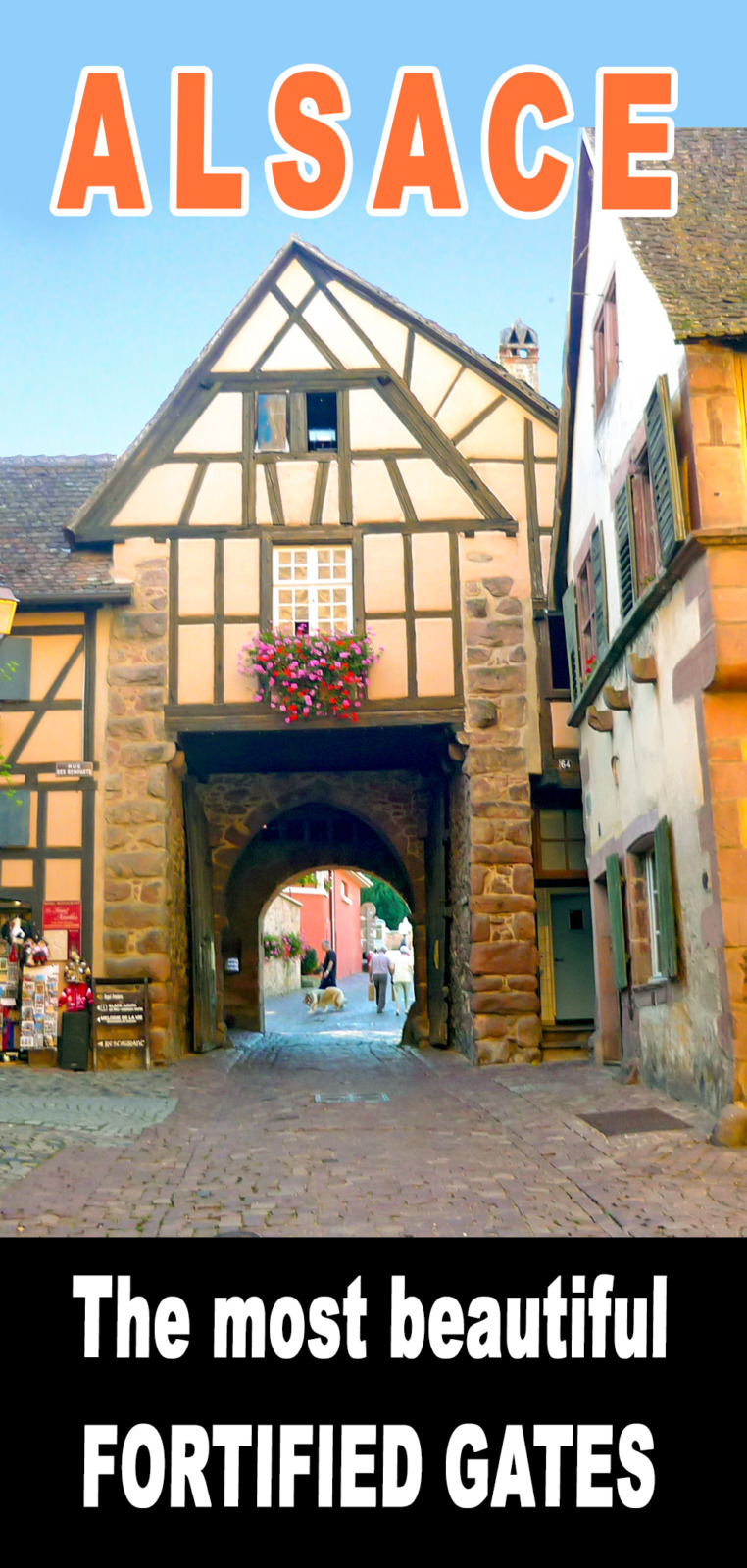




Fascinating article!
Thank you Ben! 👋
Pierre, I have always loved the Alsace, it is so beautiful & have taken many British groups there, both for wine tastings, Christmas markets or just to visit. Thank you for this article. X
It’s always a pleasure! Thank you Ann!